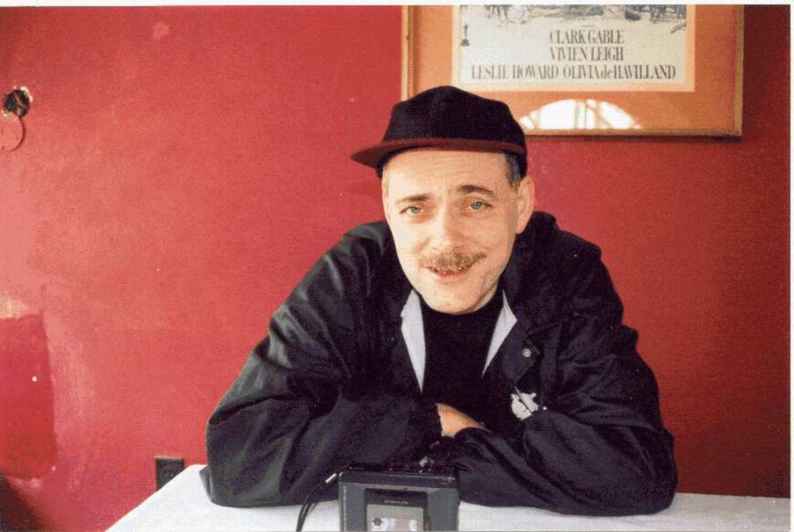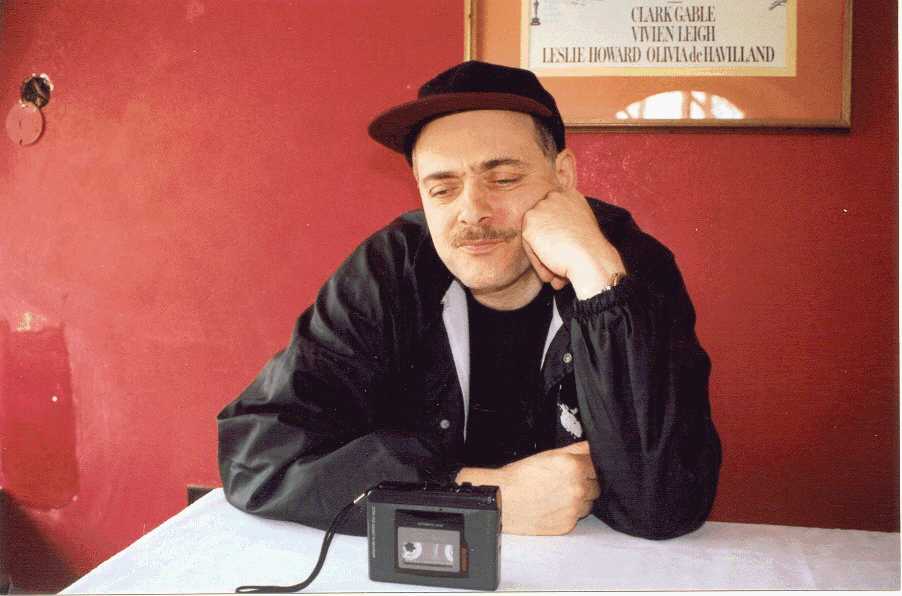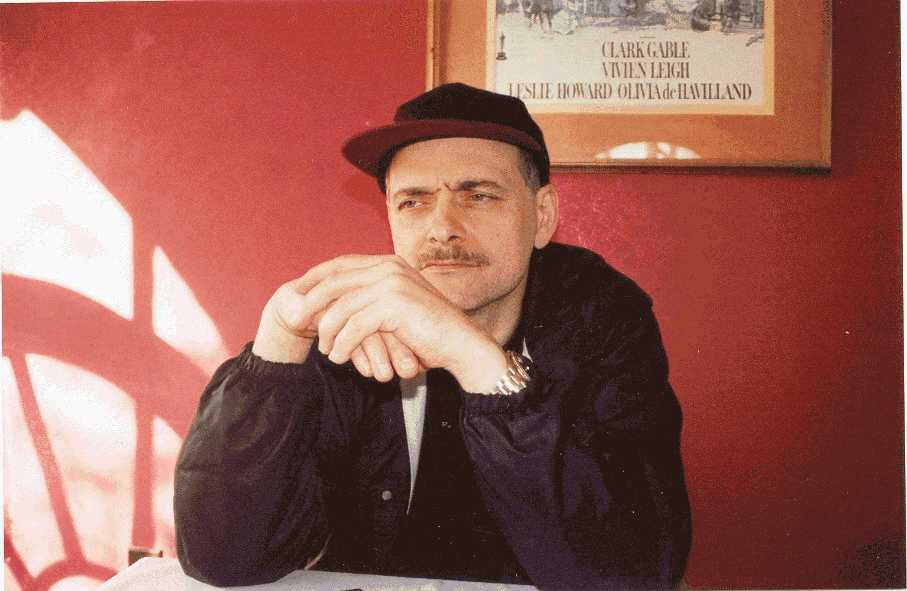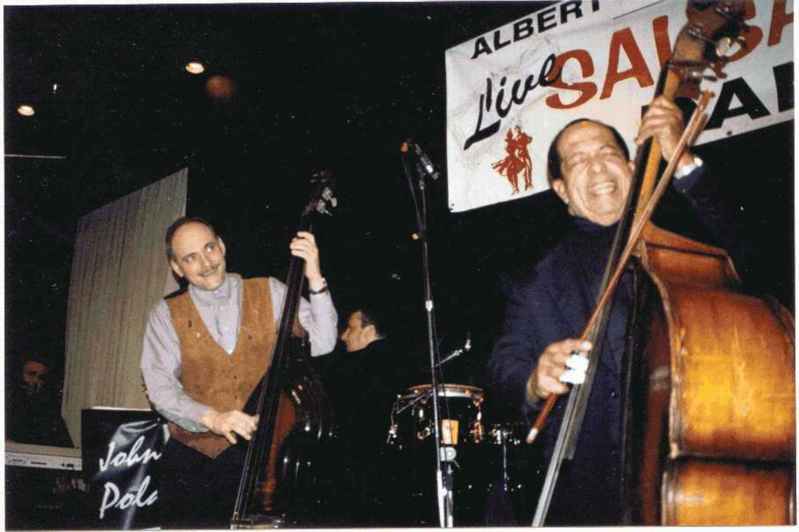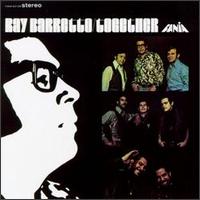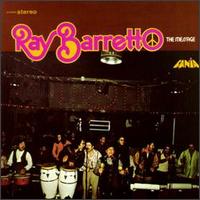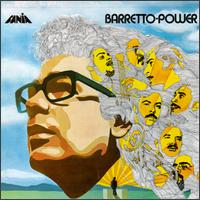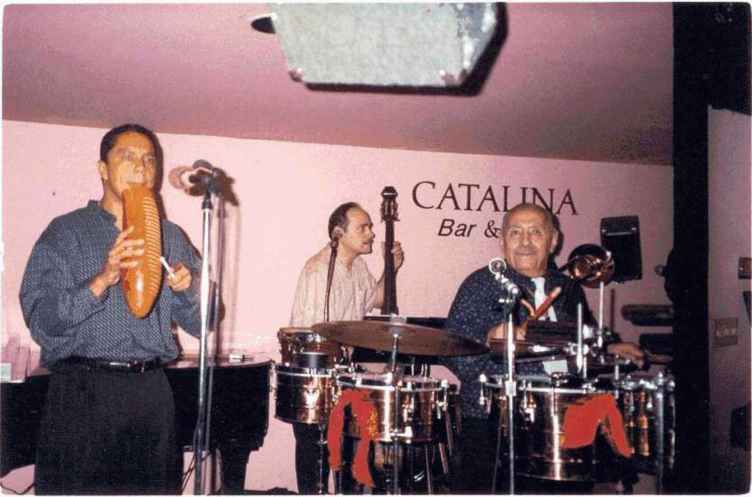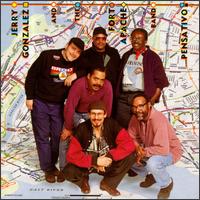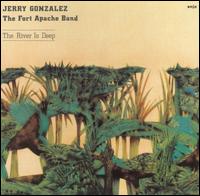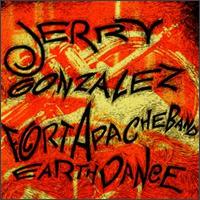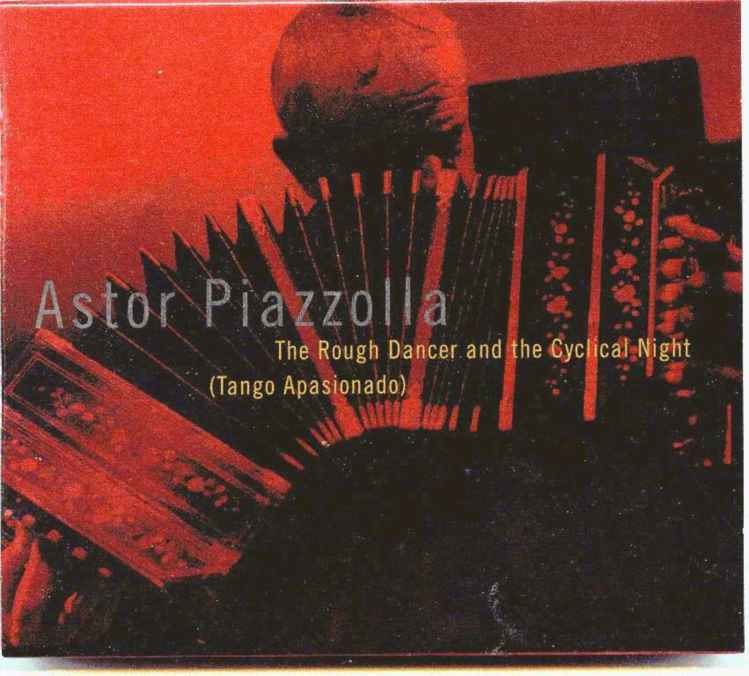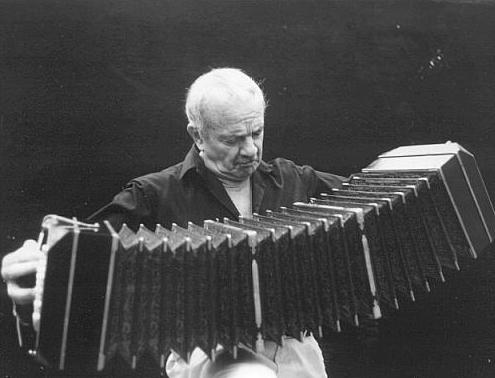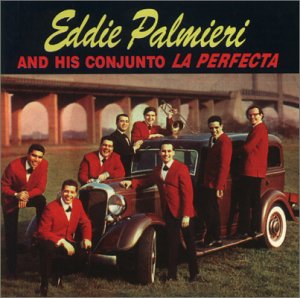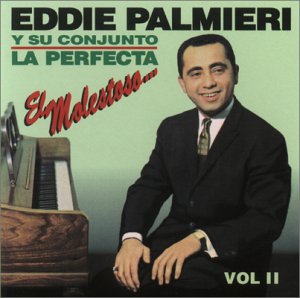The Cultural Warrior: Andy González
|
Andy González. Photo by ©Eric González |
Text and photography by ©Eric González
Interview conducted on March 9, 2002; April 25 and 26, 2004; and March 26 and 27, 2005.
INTRODUCTION
The original title of this interview was going to be “The Experience, Passion, and Intensity of Andy González.” Experience, because he has been playing since the sixties, and has performed with the who’s who in afrocuban music in New York City. Passion, because in addition of being a talented bassist, he is also a historian of our music – he knows it very well. And Intensity, because he reflects it when he’s playing. You can see it in his movements; you can see it in his eyes. But, for some reason, I felt that my title was missing something. Maybe it had too much. It was Andy, himself, who suggested “The Cultural Warrior.” That was it for me. That’s what being creative all is about. Everything that he is, musically and historically speaking, is represented with this title.
A native Newyorican, Andy González has seen it all, and, what he hasn’t seen, he has researched and can give you a reasonable answer. He has played with the best afrocuban groups and some of the best jazz bands in current times. At age sixteen, he was performing and recording with Monguito Santamaría. He graduated and moved on to be part of or record with the best bands, such as Ray Barretto, Dizzy Gillespie, Eddie Palmieri, Rubén Blades and Willie Colón, Willie Colón, Tito Puente, Bobby Vince Paunetto, Tito Rodríguez, Tito Puente, Kip Hanrahan, Deep Rumba, Astor Piazzolla, Virgilio Martí, La Lupe, Ismael Rivera, Chico O’Farrill, Grupo Folklórico y Experimental Nuevayorquino, and many, many more. According to González, he has done over 800 recording from 1962 to 2005.
However, Andy González’ legacy will mainly be remembered because he was an integral part of two very important groups: Libre and the Fort Apache Band. You can even ignore all his work with other bands, if you will. His contributions with Libre and the Fort Apache Band are sufficient for this fabulous bassist to secure a place in history.
Created in the seventies by master percussionist Manny Oquendo and Andy González, Libre is a seminal group in the development of salsa music in New York. The have survived all these years, including the merengue and salsa monga periods that negatively affected afrocuban music as we know it. And they never, ever sold their artistry. They continue to create music for our enjoyment, and they are true heroes in salsa music.
The Fort Apache Band is, in my opinion, the most creative group of this thing that we call Latin Jazz. With them, you really get both afrocuban music and jazz – you don’t need to burn your brain to figure it out. As you will read again further down, I constantly tell people that Latin or afrocuban jazz can be divided into two groups: Before and After the Fort Apache Band. This is the school, my dear friends. What began as a group of fellas jamming and playing Latin Jazz, has evolved into an institution, under the experienced direction of Jerry and Andy González.
My interview with el maestro Andy González took place in the Culver Hotel, in Culver City, California, not far from the MGM movie studios. The previous night, he performed a marvelous set with master bassist Cachao and the Johnny Polanco orchestra, with guest star Camilo Azuquita. Andy was not scheduled to appear in that presentation. He was in another part of Los Angeles, playing with a jazz trio. As soon as promoter extraordinaire Albert Torres learned that Andy was in town, he sent somebody to pick him up and bring him to the Sportsmen’s Lodge, where Cachao was featured. The result of this effort was memorable for all of us who witnessed that magic encounter of the teacher (Cachao) and the student (González).
I interviewed Andy again by telephone two years later. He was convalescing in medical care facility in the Bronx, New York. Andy was recovering from surgery, caused by an infamous disease known as diabetes. He was in good spirits and very anxious to play music again. In fact, during both interviews —2002 and 2004—, this cultural warrior was always eager to talk about his career and his love for true artistry.
The following day after my interview on April 26, 2004, a benefit for Andy González took take place in the world famous Birdland, in New York City. This gala was made possible due to the efforts of pianist Arturo O’Farrill, son of the late Chico O’Farrill. Some of the guests scheduled to appear were Ray Barretto, Manny Oquendo y Libre, Graciela, Eddie Palmieri, and many others.
Andy González, together with Manny Oquendo, will also be honored in the 6th Annual West Coast Salsa Congress, in Los Angeles, California, on May 27-30, 2004, organized by Albert Torres Productions.
It means a lot that this incredibly talented musician will be honored in his lifetime. His contributions to music, in particular to salsa and jazz, will stay, and stay forever.
Acknowledgements: My gratitude to Israel Sánchez-Coll for generously making this interview more enjoyable to the eye. I am also very thankful to Eddie Zervigón, Albert Torres, and Carlos Rowe for all the help that they provided.
THE INTERVIEW:
Eric E. González (EEG): OK, Andy, it is my understanding that you were born on January 1, 1951. Is that right?
Andy. González (AG): Yes.
EEG: Tell me a little bit about your early years.
AG: I was born in Manhattan, and raised in The Bronx. When I was around two years old, we moved to a low-income housing project – “the projects” – in New York City, called the “Eden Wald Housing Projects,” up in the North Bronx. At the time, it was the largest housing project in the city, and it still exists. Thousands and thousands of people lived there, families with low-income.
My father used to work as a contractor; he used to do painting, fixing houses, and stuff like that. And he was also a singer. He used to sing with small bands. He got to sing with Claudio Ferrer, who is a very well-known Puerto Rican band leader, a folklorist. When my brother Jerry was one-year old, he hired Claudio Ferrer’s band to perform at my brother’s first birthday party! Claudio Ferrer to Puerto Ricans is very well respected.
We lived and grew up in the projects and went to public schools. That’s where we first got music lessons, in the public school system in New York City. All the kids in the second grade started playing plastic flutes – a tonette, they used to call it. It was a plastic flute, with a two to two scale, one octave. So, I learned how to play the tonette, learned how to read.
EEG: Approximately what year are you talking about?
AG: Probably 1957.
The school that we went to was PS 78 (Public School 78), which was an older type of school in the New York City school system. Now, PS 78 had a lot of old teachers there, which had been teaching in that school for years, probably since the early forties or something like that. And they were good music teachers. This was before the system changed to public school, elementary school, junior high school and high school. It changed. It used to be that elementary school used to go to the eight grade, and in the ninth grade you go to high school. There was no junior high school. So a lot of these teachers came from teaching in this PS 78 school, teaching all these subjects, especially music education – a very good music education! --, all the way to the eight grade and then you would go to high school. So, when they changed the school [system] and they put junior high school, a lot of these teachers stayed in that school, in the elementary school, and then you would go to the sixth grade and then you would go to junior high school. But, in the third grade, they gave you a test for the music, to check your musical aptitudes, and in the fourth grade you took instruction from one of the teachers on the instrument. And, in the fifth or sixth grade, you played in an orchestra.
|
EEG:
What instrument were you
playing at that time? AG: I was playing the violin. I picked the violin and played it for a year and a half. I was in the orchestra already, and then one of the bass players – there were two bass players – moved away, so there was a need for a bass player, and I was the tallest violinist. I was playing in the second violin section. And so they asked me if I wanted to play the bass, and I said, “Sure, I’ll give it a try.” So I started playing the bass then. EEG: What was Jerry, your brother, playing? AG: Jerry was playing trumpet. He was taking trumpet lessons in school. He didn’t start playing congas until the eight grade. EEG: How older is Jerry from you? AG: He is a year and a half older than me. EEG: Did you use to play music together at home in those early years? AG: Yes. EEG: Did you continue studying music after you finished high school? |
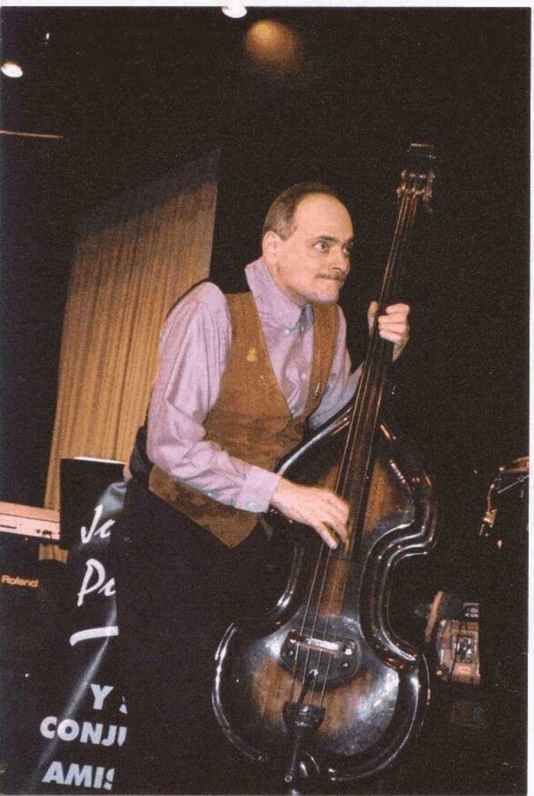 |
AG: Well, yeah… Let me explain. The system of teaching music in the elementary school was excellent…excellent! My teacher for our very first performance in front of an audience in the auditorium for the parents, she had us play a Duke Ellington tune! With violins! A tune called “Solitude.” And, you know, I never thought nothing of it, until years later, [about] how hip she was to have us play some Duke Ellington at such a young age.
EEG: What type of music was listened in your home at that time?
AG: We used to hear everything. My father had a good record collection – Machito, Tito Rodríguez, Tito Puente, Ismael Rivera, Cortijo. Mon Rivera… All these things we used to hear. And my family had many parties, and they used to play all these records at those family parties.
EEG: What about jazz?
AG: Not so much jazz. My father brought home our first jazz record, a Charlie Parker album. He brought home Dinah Washington with Clifford Brown, and a Dizzy Gillespie record.
EEG: Where you listening to them, or they were boring to you at that time?
AG: No, it wasn’t boring to me at all.
EEG: Who got hooked on jazz first: Jerry or you?
AG: Both of us. My uncle had a Cal Tjader record in the house, when we were kids, and it was a red record. I never saw a red record before —red viny—, and when we played it, we liked the sound of the vibes.
EEG: I understand that Cal Tjader was a big influence in you.
AG: Oh, yes, because they were really a more jazz-oriented Latin group.
EEG: I was able to learn about your tastes in an album that Manny Oquendo and you put together for Verve, named “More than Mambo,” a great compilation, with good liner notes. (1)
AG: Yeah. I compiled the music, and then me and Manny did the liner notes. I put it together in 20 minutes. They gave me a list of their catalog – everything that they had. And then I went through it and picked out everything that I liked.
|
|
|
EEG: There is a tune in that compilation that I really enjoy, named “Insight,” played by Cal Tjader. It’s amazing that all the personnel in that track are non-Latinos, including the conga player – an African American named Bill Fitch --, who executed a great solo. And that was in 1963!
AG: Bill Fitch was a smart guy that studied at Berklee School of Music, and he is a composer and a great percussionist. His idols were Mongo [Santamaría], Armando Peraza, and Tata Güines. You can tell, by listening to the solo. He influenced us, just from that record – “Insight” --, because we have heard that record a long time ago, and it was always a big influence on us.
EEG: What happened to him? He kind of faded out of the scene.
AG: Well, he had a problem, an alcohol problem. When he was with Cal Tjader, he got fired because the alcoholism had gotten too bad. He became irresponsible, drunk on gigs and stuff like that.
EEG: Back to your early years. When did you begin taking the music to the next level?
AG: Well, pretty early. I mean, I was playing the bass already by the sixth grade; I was in the orchestra playing the bass. And we started messing around, doing little jam sessions in the projects where I lived, with all the people that I knew that played congas. And then, my brother’s girlfriend father was a timbalero, and he had the Cachao records —“Cuban Jam Sessions in Miniature”—, and we went crazy over that!
By the time that I got into Junior High School, we started a band. It was [with] a friend of mine —a vibes player. His name was Andy Langston, and we just called it the Andy Langston Quintet. He was an African American that played the vibraphone.
But the guy that really put us to really listen and play good music was Lew Matthews, who lives here in Los Angeles. He is the musical director for Nancy Wilson. When we were kids, he lived in the Bronx; he lived nearby, and he was the genius of the Bronx. He was, to my knowledge, the most talented musical person that lived in the Bronx. He was a few years older than us; he was in the Music & Art High School, which is a high school that I went to later on. He was there already. I was in Junior High School, and we met Llewellen Matthews, and he had us go to his house.
EEG: Llewellen?
AG: It’s an unusual name. They called him Lew —Lew Matthews—, but Llewellen is his real name. His dad was black and his mother was white, and he looked Latino, very Latino. In school, he was a French horn mayor – that was his instrument, the French horn. He played great piano, and he could play vibes, he could play bass… he could play all kinds of instruments.
EEG: I guess that he also had his tumbao.
AG: Yes, and he had clave, and played like a Latino. He liked Latin music, especially Latin jazz. I would go to his house, and I take my bass over there. Then he started a big band —I was thirteen or fourteen years old!—, and we played very mature, sophisticated Latin jazz at that time.
EEG: Was Jerry with you all that time?
AG: Yes!
EEG: What type of bass was your first one?
AG: I borrowed it from Junior High School; it was an instrument that they had in the school – a wood bass. I used to borrow it and take it to gigs.
I remember our first big dance. I was thirteen, and we played at the Embassy Ballroom, on 161st, off of Third Avenue, in the Bronx. And this was a famous ballroom, you know. It was Sunday afternoon. Federico Pagani (2), the promoter, used to throw these Sunday matinees – ten attractions --, and we were the tenth attraction (LAUGTHER BY ANDY AND ERIC). The first on the bill was Tito Rodriguez, the second was Eddie Palmieri y La Perfecta, and the third was the Joe Cuba Sextet.
EEG: What band were you playing with at the Embassy?
AG: We played there with the quintet, with the Latin Jazz Quintet, a copy of Cal Tjader, but Lew Matthews was the piano player.
EEG: Who were the other players in the quintet?
AG: Jerry [González] on the congas, I was playing the bass, Lew on the piano, Andy Langston on the vibes, and Arnold Saunders on timbales. Arnold was a black guy that was neighbors with Andy Langston and he knew how to play timbales.
EEG: Did Arnold Saunders have clave?
AG: Yeah! There were many African-Americans that liked Latin music. In those years, black people used to go dancing at the Palladium. So there was a lot of cross-fertilization.
EEG: The Palladium was famous for catering to several ethnic groups. They had Latin nights for Italians, Jews, African-Americans, Latinos, and mixed.
AG: Sure, sure… Everybody used to dance Latino! In the projects where we lived, we used to go to the parties of our friends. And we used to go to white people’s parties; white people could dance Latin!
EEG: I understand that you also played in the Catskills.
AG: Yeah, yeah! Las Villas, they used to call it. Villa Alegre, Villa Toto, Villa Victoria, Sunny Acres… Every villa had a name. Those were places to which city people went all summers, and stayed for a week, or two weeks. They had swimming pools and all that, and they also had New York bands playing there.
EEG: Which bands did you played with in the Catskills?
AG: Well, I played with the band that my father used to sing with. My father was an MC in the Catskills.
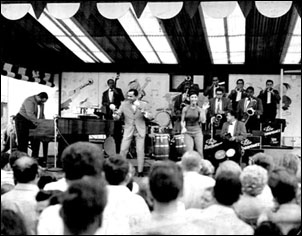 |
EEG: What was his name? AG: Gerardo González. EEG: What was the band’s name? AG: Augie (de Agustín) Meléndez y su Combo. The band’s sounds were similar to La Playa Sextet —guitars, trumpets—, that kind of sound. They copied the arrangements of everything that was popular at the time: Tito Rodriguez, Machito, la Playa Sextet… They never recorded —never—, but they played a lot. There were many places to play during those times. They were also hired to play a whole summer in Las Villas.
|
EEG: What was your mother’s name?
AG: Julia Toyos. Some members of her family went to Cuba, and there is a bakery in Old Havana, which is very famous, and that’s the Toyos bakery.
EEG: What happened next?
AG: We were with Andy Langston and his group for about two or three years. Then, I met Mongo Santamaria’s son —Monguito—, began playing with him, and made my first recording in 1967.
EEG: How many albums did you do with Monguito?
AG: Three records: “On Top” (1967), “Hey Sister” (1968), and “En una Nota” (1969). When I did “En una nota,” I wasn’t in Monguito’s band anymore, because I joined Ray Barretto’s band. (3)
EEG: I imagine that you played a lot of boogaloo with Monguito.
AG: Boogaloo, Latin jazz..., you know, we played everywhere, because there was a boogaloo fever at that time. There were a lot of young bands playing those genera.
EEG: Tell me a little bit about Monguito. Little is known about him. How was he as a person and as a musician?
AG: Well, he was a good person... But he was not a strong pianist. He wasn’t the best piano player in the world – let’s put it that way. He had enough technique to play the gig, but he wasn’t a great pianist. He could play the boogaloo stuff, and he could play solos, but he wasn’t Lewellen Matthews, who was a great pianist. And he wasn’t some of piano players that were around at the time. But he was good enough to just play the gig.
EEG: Did you learn or accomplish anything during your time with Monguito?
AG: Well, we made our first recordings, and then, in the group there were good people: Jackie McClean’s son – great saxophonist, Rene McClean. We had good musicians; I think that Monguito was the least accomplished one of the bunch. And he was the leader! (LAUGHTER BY ERIC) There were also José Mangual Jr., who was the bongocero, and Sam Turner on the congas. Sam Turner also got to play percussion with Lionel Hampton and other people.
EEG: Whatever happened to Monguito? He kind of disappeared.
AG: Yeah, because he just decided not to involve himself in music anymore. He used to work for years as the manager of an off-track betting [agency], you know, horse racing. And then he moved to Miami; he lives in Miami now. But we did some good things. We worked in the circuit; we did all the places where they had dances. We also traveled to Puerto Rico.
EEG: It is my understanding that some of the bassists that you were listening to were Sabino, Cachao, Bobby Rodríguez, and Cuco Sánchez. Please tell me about Sabino and Cuco Sánchez.
AG: Sabino Peñalver was Chappottín’s bassist. Cuco Sánchez was the bassist for Melodías del Cuarenta and he also played with Arcaño’s Orchestra. Sabino was Chappottín’s bassist since the beginning, and played all the way to the end, I believe, when Chappottín died or was about to die. He was a great bassist, not so much in technique, but in the feeling and the tumbao – he always had un tumbao sabroso!
Cuco Sánchez was a bassist in Cuba. He played with Arcaño, with Melodías del Cuarenta, and with a great charanga. He had an incredible swing and ability with the bass. The only bad thing is that he didn’t know how to read, and, when he moved to New York, he stopped playing the bass, and began playing the timbales. He is included in a couple of Cal Tjader’s recordings — “Ritmo caliente” being one of them—, and Cuco is there playing the timbales. Cuco was friends with Mongo Santamaría, and he played in a charanga —El Nuevo Ritmo de Cuba—, which was a charanga from Chicago, with great Cuban musicians, and Cuco was the timbalero. He teached Víctor Venegas to play bass with tumbao. Víctor Venegas was a jazz musician, and it was Cuco who taught him tumbao. (4)
EEG: I was recently listening to the album “Mongo Introduces La Lupe,” and you can notice Venegas playing with that tumbao that you mention. It sounds funky, when that style was not popular in afrocuban music.
AG: I know that record really well. I copied a lot of things from that record. I was listening to a lot of records. We were buying records, we were buying all the popular records, [like] Alegre All–Stars, which is one of my favorite Bobby Rodríguez [albums]. And I used to go see Tito Puente’s band playing and watch Bobby Rodriguez. I was standing in front of Bobby Rodriguez, and I wouldn’t move a muscle —I watched everything he did.
When I was with Monguito, we played a gig opposite Tito Puente at the Corso, and Bobby Rodriguez asked me to play with the Tito Puente band so that he could go to the bar. (LAUGHTER BY ERIC)
EEG: I imagine that that was a highlight for you.
AG: Sure! Playing with Tito Puente’s band? I was sixteen-years old!
EEG: Did you ever play with Puente for a long period of time?
AG: I played occasionally with the Big Band as a substitute. When I was with the Golden Latin Jazz All-Stars, we did long tours. Before that, in 1978, I went with the very first Latin Jazz ensemble to Japan —it was the Tito Puente and the Latin Percussion Jazz Ensemble.
EEG: Is that the same group that played at the Montreux Jazz Festival?
AG: Yes, but they fired me when the Montreux album came out, for some stupid reason. (5)
EEG: Mike Viñas replaced you, I believe…
AG: Yeah, Mike Viñas. I wasn’t fired from many bands, but I was fired from that one, because there was some problem with Martin Cohen, not with the musicians. I brought Jorge Dalto into the band —nobody knows that.
EEG: I was lucky to see Jorge Dalto performing with Ray Barretto in the 80s. Tell me about him.
AG: Jorge Dalto was a beautiful pianist, man, great musician. He started playing with us with the Fort Apache [Band].
EEG: Now that you mentioned the great Fort Apache Band, and before they recorded “Ya yo me curé,” Who were the original members of the band, the creators?
AG: Well, on that very first record, Steve Berrios is not there —that was Don Alias. Don Alias played the trap; he only played on one tune, though.
EEG: How come Don Alias didn’t continue with Fort Apache?
AG: He was our friend. He played percussion with Miles Davis and many others, including the Brecker Brothers (Randy and Mike) and David Sanborn. So he could not be with us.
He is from the Caribbean island of San Martín. He used to play Latin jazz, and with small groups in Las Villas, before he got involved with jazz. But he has always been our friend.
EEG: When did Jorge Dalto play with the Fort Apache Band?
AG: Well, Jorge Dalto was the pianist that worked with us in “River is Deep.” That was the first “official” Fort Apache record, because “Ya yo me curé” wasn’t a Ford Apache record. That was Jerry’s [González] first recording session, and he didn’t want to put it under his name. He wanted to put a group name, and I said, “Put it under your name! Make it your record. Why not? You might as well start now.”
EEG: So “Ya yo me curé” is not a Fort Apache Band recording.
AG: No. It’s “Jerry González —Ya yo me curé.”
EEG: And the first Fort Apache is “River is Deep.” Interesting. I would have never known. OK. Let’s continue with your career. What happened after you left Monguito Santamaría’s band?
AG: I left to go with Ray Barretto’s band. Ray Barreto saw me play. Monguito Santamaría had a good band; we had a very tight band! And we had a guy singing English vocals, like a soul singer —Ronny Marks was his name, and he put on a good show! We opened for the “live” recording of the Fania All-Stars in the Red Garter. That first record, we were the other band!
EEG: Can you please tell me more about that concert? That was the first attempt for the creation of the Fania All-Stars, which was not successful.
AG: I remember all the things that I heard on the record, all the people that were there. Ray Barretto saw me play with Monguito, and he came and asked me if I could join his band.
EEG: Who was the bass player that you replaced at Barretto’s band?
AG: Mike Amitín. He was the bass player for Orquesta Broadway for years, but at that time he was working with Barretto.
EEG: Why did Barretto wanted to replace him?
AG: Because there was a fire in the “Corso,” and I don’t know, but he —Mike Amitín— did something weird that Barretto didn’t like, so he fired him.
EEG: What do you think went wrong at the concert of the Fania All-Stars at the Red Garter, that didn’t allow them to take off?
AG: I don’t think that anything happened; there wasn’t anything wrong. See, at the time, the Alegre All-Stars had a few records out already, so Fania wanted to copy that. And the Tico Alegre All-Stars put something out at the Village Gate, so Fania wanted to get into the ball. They went and they got Eddie Palmieri, who wasn’t a Fania artist, and a couple of other people who weren’t Fania artists, but they put them together. Bobby Rodríguez was the bass player, which was good. I thought that those records weren’t bad.
EEG: Bobby Rodríguez was really good.
AG: Of course! – him and Cachao are my two daddies, man. (ERIC’S LAUGHTER) I didn’t copy them, although if you ask me to play like their styles, I can do that. But I never copied them.
EEG: If you have to compare your style with somebody, who would that be?
AG: Oh, I couldn’t tell you, because I have too many influences. I learned something from every bass player that I have ever heard. What I do is a combination of everything that I have learned, so I can’t pin it down. But, if you tell me, “Play like Cachao!” I can play just like him. If you tell me, “Play like Bobby Rodriguez!” I can play just like him.
|
A. González and Cachao. Photo by ©E. González |
EEG: What can you tell me about Salvador Cuevas? He was very funky, and I don’t think that you are too much into that.
AG: Well, funky is what? Slapping the bass? That, he did on a bass guitar. Sal Cuevas comes from the tradition of the trios, he played guitar. So playing the bass guitar was very easy for him. He brought the funk technique or slap technique to Latin music, with Willie Colón and Rubén Blades
EEG: He was the first one?
AG: Yes, he was the first one.
EEG: But Víctor Venegas also does some funky bass on the CD with Mongo and La Lupe.
AG: Nope, there was nobody else, man. No, no, no, no. I know that solo by heart.
EEG: OK. You did three albums with Ray Barretto: Barretto Power, The Message, and Together.
|
|
|
|
AG: “Together” was the first one in 1969. But I left the band after two years. I left the band to go with Dizzy Gillespie. Then I came back to Barretto and stayed another year.
EEG: Was Jerry, your brother, ever part of Barretto’s band? You can see him in the cover of “The Message.”
AG: Jerry used to come and sit in with the trumpet section, and a couple of times Barretto got sick, and Jerry played the congas for him.
EEG: When did Jerry switch from congas to trumpet?
AG: He didn’t switch from congas to trumpet. He always played the trumpet. And he started playing the congas because of a “lucky” accident: he broke his leg. When he was in the eight grade, and I was in the sixth grade, near the housing projects where we lived there was a forest behind our Junior High School. And, in that forest, they had woods, in which we used to go and play, and there was a swing —a rope, that they tied to a tree. And Jerry swung from that rope, and it was on a hill, so when you go out, the hill was far down. So he did like Tarzan, you know, he swung on the rope and jumped down, and he did all right, but nobody saw it. So he wanted to show everybody —show up—, and said, “Watch this!”, and did it again, and he fell and broke his legs in three places. (LAUGHTER BY ANDY AND ERIC) He had a full cast and he couldn’t walk, he couldn’t go to school. So they had somebody come and teach classes to him in our apartment. So he had a lot of time in his hands, and somebody loaned him a conga drum, and he started practicing with records —with Mongo Santamaría records, with Tito Rodríguez and Tito Puente records…That’s how Jerry learned how to play the congas.
EEG: When did you begin getting musicians together at home? Was that during Barretto’s years?
AG: It was during Barretto’s time, because my parents moved us out of the projects when I was still with Monguito, and they bought a house.
EEG: Is that the one showed in the movie “Calle 54”?
AG: Yes!, that house. I started going to high school then, when I was with Monguito. I went through my first year of Music and Arts High School. Oh!, and in Junior High School, in my eight and ninth grades, I started studying with jazz bass player Steve Swallow, a very well-known composer and bassist. At that time, he was the bassist for Stan Getz, when he was recording “The Girl of Ipanema,” with Astrud Gilberto. Then, he left to play with vibraphonist Gary Burton and his quartet. So I studied with him for about two or three years. He helped me get into Music and Arts [High School]. He wrote an adaptation of a Bach Cello Suite that I played to get into Music and Arts for my audition.
EEG: How long were you at the Music and Arts High School?
AG: Three years, the usual three years high school. That school brought students from all over the city, so I was in touch with good musicians from all over -- people like Dave Valentín, Eddie Gómez, Larry Willis… A lot of people went to Music and Arts. If you were talented in music, there were two schools of music that you would go for high school: Music and Arts High School and Performing Arts High School.
EEG: I understand that René López was also very important in your life.
AG: René López lived in my neighborhood. I met him through Nicky Marrero; Nicky lived in the neighborhood, too. Nicky was playing with Eddie Palmieri and I was playing with Ray Barretto, and we found out that René had one of the greatest collections of Cuban 78’’. And he loved to play them, he loved to have people listen to them. He had a good hi-fi system, and those 78’’ sounded great on that system – the bass, a powerful bass! So I fell in love with Arsenio Rodriguez and all the Cuban bands! All the Cuban bass players… I listened to everything! And then I started collecting records, too. I started collecting 78’’, because there were still places to get them.
EEG: Can you name some of those places?
AG: I’m talking about places like “La Cigueña.” There was [also] a place at Westchester Avenue and 163rd Street. “La Cigueña” had a whole basement full of 78”, and they wanted to get rid of them!
At the time, we started a radio show —the first Sunday salsa show. And we started playing Cuban music on the First Sunday salsa show. They never heard that music on the radio. Ever!
Felipe Luciano was one of the Young Lords —that was political group like the Black Panthers —, and they were trying to fight for the rights of the Puerto Ricans in el Barrio, because there was no good health care, the children were not having food, a lot of things – and they were fighting for those things. Felipe Luciano was one of the leaders of that group. We started hanging out, and he was also a music fan, and then they gave him an opportunity to have his own radio show. First, it was Sunday midnight through six in the morning. It was a Latin radio show. So he asked me and René López, and we were the ones that programmed the music. And, for the first time in years, we were able to hear Cuban music on the radio, because you never heard Cuban music on the radio before that.
EEG: What was the name of the show?
AG: It was the Sunday Salsa Show with Felipe Luciano, and the station was WRVR.
EEG: Was that before Polito Vega?
AG: Yes. At the time, he (Vega) didn’t play salsa in his show. He played popular Hispanic music. Ours was more into salsa.
EEG: So that was before Fania began buying radio time.
AG: Yes. This was the first time that any kind of show – not only music –, that talked about the history of the music, or anything like that, had been done, because this was a non-profit radio station. In other words, there were no sponsors, so you could play what you wanted! WRVR sold the station, but the program switched to WKCR, which is Columbia University’s radio station.
EEG: So your show was probably originated years after Dick “Ricardo” Sugar.
AG: Oh, yes. Dick Ricardo had a show in the mid-sixties that was very popular. That was a show that I listened to a lot. They had two radio shows: the Dick “Ricardo” Sugar on FM, in the mid-sixties, and on AM was “Symphony” Sid. “Symphony” Sid used to be a jazz radio DJ, and then, little by little, he started going into Latin jazz, and then into salsa.
EEG: Where the records that you played in the radio show Cuban originals?
AG: Sure! RCA Victor, Panart, all the labels…
EEG: Now that you mentioned Panart, and that you are also a music historian, Was Julio Gutierrez responsible of creating the first descargas, instead of Cachao?
AG: No! Wrong! Not even Julio Gutierrez. Julio Gutierrez was a piano player and mostly a bolerista —boleros, shows, and hotel music. He played on that Cuban Jam Session album, but he wasn’t the leader of it. The real piano player, who really should have gotten credit, was Peruchín. Peruchín was the piano player on the best tracks of that [album]. And he wasn’t even the inventor of the descarga! You know who it was? Bebo Valdéz. Bebo Valdéz did the very first descarga record.
EEG: Do you remember the name of that recording?
AG: No, but it was in 1954.
EEG: Going back to your house, which became kind of famous because great musicians used to hang out at the basement. When did that start?
AG: It started the first minute me moved in, we started jamming, because me and my brother had the basement apartment for ourselves. We had a piano… we had everything. We had a full studio in there. I had three reel to reel tape decks, I had a good hi-fi system… So we used to jam all the time —all kinds of music, not just música latina.
EEG: How big was that basement? Can you tell me the address?
AG: It wasn’t big, but it was comfortable. [The address] was 1963 Gildersleeve Avenue, in the South East Bronx, in New York.
EEG: Can you share any significant moments that you had in that basement?
AG: Oh! The beginning rehearsals of Libre, the beginning rehearsals of Grupo Folklórico Experimental Nuevayorquino, rehearsals with Eddie Palmieri —we used to rehearse in my basement sometimes; very few rehearsals. Dizzy Gillespie used to come to my house… Many people— just about everybody at one time or another had been to my house.
EEG: I read that Bobby Paunetto’s first album was created there.
AG: Yeah. We rehearsed it. They used to come from Boston to New York and rehearse in my house. A four-hour drive!
EEG: Did you play in that album? What else can you tell me about Bobby Paunetto.
|
AG: Sure, [I played] in that album. Bobby Paunetto is a composer and vibraphonist, and I know him since I was a kid, since I used to rehearse with the big band in Lew Matthews’ house. He used to come to the rehearsals. At that time, he started his own Latin jazz band, and he put out a record on Mardi-Grass Records, called “The Modernistic Sounds of Bobby Paunetto.” It was a vibraphone and a rhythm section; I think it had a sax, but I don’t remember. Then he went to the army, and, when he came out, he went to the Berklee School of Music, and studied composition and arranging. When he graduated from school, he started a very, very modern band – probably one of the most modern Latin jazz bands of its time—, and I was part of it. We recorded two albums: The first one was called “Paunetto’s Point” and the second one was “Commit to Memory.” All that music was rehearsed in my house! (6) |
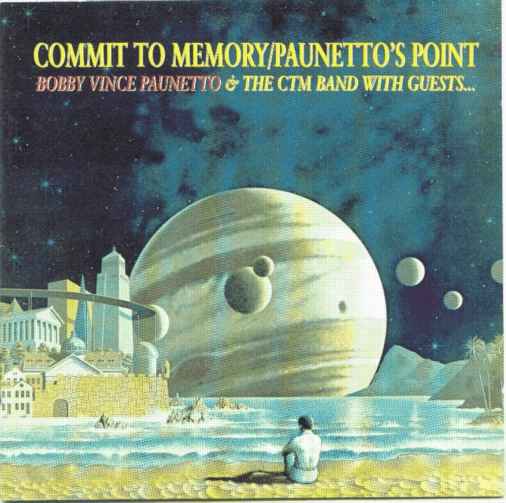 |
EEG: He didn’t have a long career, Right?
AG: No, because he got sick with multiple-sclerosis. But he [recently] came out with new music again! He’s not playing, but he’s writing, and he did two records, [with] all new music. It’s more jazz.
EEG: OK, let’s get back to track. You spent some time playing with Dizzy Gillespie. How did you hook up with him?
AG: Jerry got the gig first. Jerry got the gig to play congas with Gillespie, and they needed a bass player that could feel Latin music, and know some jazz, so they called me.
EEG: What year are we talking about?
AG: 1970. I was nineteen years old, and I spent eight months working in his band. And then, after that, we were in touch all the time, you know. When he had his 70th birthday party, I was at the concert. I was there, and he saw me, and he brought me up to the stage and introduced me and [said] that I used to work with his band.
EEG: So Gillespie was the entrance to the major leagues in jazz.
AG: Well, yeah, playing with a big name…Yeah, definitely! But, at the same time, I knew Kenny Dorham, Jackie McClean… lot of musicians that we knew when we were kids.
EEG: What do you consider was your schooling in jazz?
AG: Mostly through records. When I was a kid, somebody’s father wanted to get rid of all his Downbeat magazines. I took them, I took hundreds of them, going back to the early fifties. And I studied them. I have been reading books, and I have been reading about the history of jazz since I was a little kid. So I got my knowledge from all the books that existed on jazz – the history, the biographies… And the records! I have a big jazz collection, so I know about everybody. I can tell you about every bass player in jazz going back to the beginning of jazz. I used that same technique when I started studying Cuban music; it was more difficult because there were no books! There were very few books on the subject. So I have to get my information from just listening to records.
EEG: Did you ever made a record with Gillespie?
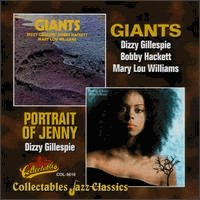 |
AG: Yeah! We made one record; it’s called “Portrait of Jenny.” Jerry played [in that recording], Patato played, and Nicky Marrero played. It’s on Perception Records. (7) EEG: Did you record jazz before that album? AG: Kind of. When I was even younger, some guy was opening a new studio in White Plains, New York, and this drummer named Alvin Queen —he was a very famous jazz drummer— invited Lewellen, and Lewellen brought me and Jerry, and we did a jazz recording when we were kids. I have never heard it to this day, but I remember doing it. It was recorded just to see if the recording equipment worked right.
|
EEG: It disappeared.
AG: Yeah, yeah, it disappeared. But I have a 45’’ of a Rhythm & Blues thing; it was the very first recording I ever did —me, Jerry, Lewellen… Lewellen was the one that wrote the arrangements. It was “Freddy Tartt and the Emanons,” like “no names” but backwards. Freddy was a guitarist from the projects where I used to live. (LAUGHTER BY ANDY AND ERIC)
EEG: So that was your first “official” recording, before Monguito. Do you remember the date?
AG: Yeah, I have a copy of it. That was before Monguito. [It was] 1964. The playing wasn’t that bad, but the singing was horrible. It’s still funny to listen to. (LAUGHTER BY ANDY)
EEG: What can you tell me about your time with Barretto? Was it a good learning experience?
AG: Well, to this date, a lot of people think that the band that I was with was the “classic” Barretto band, [with] Orestes Vilató, Roberto Rodríguez, Papy Román, Tony Fuentes, John “Dandy” Rodríguez on bongós, Louis Cruz on piano… A lot of people to this date say that that was the “definitive” Barretto band. Everything that came afterwards or before was OK, but this band had something special.
What we had going was that we were all friends with each other. My thing was Latin jazz, and then I started studying Cuban music, so I was trying to apply what was I learning in Cuban music to Barretto’s music.
EEG: Was Barretto understanding?
AG: He didn’t tell me what to play. What I would do is, we would play the music, and I would memorize everything, and I would never have to look at the charts [again]. So then, what I would do is I would start changing the bass lines, little by little. And then, by the time I left the band, another bass player would come in and they would play the charts and the band would complain that that wasn’t what I played. I said, “Well, I changed the charts.” (LAUGHTER BY ERIC)
EEG: You were the Barretto from 1969 to 1971.Why did you leave the band?
AG: I was sort of getting tired, because all the time that I had been playing, my main thing was to play Latin jazz and to play jazz. I mean, Barretto was working a lot… I was in high school when I started with Barretto, [and] I almost didn’t graduate. (LAUGHTER BY ANDY) But I managed to get through it.
When I started with Gillespie, I was in college, and had to drop out! I had to drop out, because we were traveling. With Barretto I was also traveling; I went to Venezuela, Panamá – we went to Panamá in 1970…
EEG: Tell me about that trip to Panamá.
AAG: Oh, I loved it! We went there during the carnival, and there were bandstands every couple of blocks, with all kinds of bands playing on them. Había gente vestidos como diablitos en la calle.
EEG: Of the albums that you recorded with Barretto, which one is your favorite?
AG: I don’t know; it’s hard for me to be a judge of that. I put those records away for a long time; I didn’t hear them for twenty years. Then I listened to them, and said, “Hey, it’s not bad!”
EEG: You know, for some reason I believe that the sound of the Fania records of the early seventies was better than the late seventies. I didn’t enjoy the engineering during those last years.
AG: Oh, yeah? You know why? Because they moved to a smaller studio.
EEG: La Tierra recording studios?
AG: No. La Tierra was a big place. It was another studio on 31st St. They moved there afterwards, when they sold Fania. They changed the studio; they got rid of La Tierra. La Tierra studios were big; those were the old WOR studios.
EEG: Which studio you think was better: Good Vibrations or La Tierra?
AG: Well, La Tierra had a bigger room; Good Vibrations is all right.
EEG: Those studios, along with engineers Jon Fausty and Irv Greenbaum, were the most common names to see in LPs during the best Fania years.
AG: Fausty engineered some of it, but Irv Greenbaum was the other guy. I saw him more than I saw Fausty. The Fania era and that whole scene, I didn’t care for too much. As a matter of fact, they sort of caused their own doom, because they didn’t treat their artists right. And then, as soon as their artists could get away, they would leave.
EEG: At the beginning everything was fine and it later deteriorated.
AG: Yeah, yeah, because Masucci and his people were making all the money, and they were paying nothing to the musicians or the artists.
EEG: Were you ever invited to be part of the Fania All-Stars?
AG: Nope. Never wanted to be.
EEG: Why?
AG: Because I didn’t like them. I didn’t like all the egos, I didn’t like all the craziness. I did one recording, one tune only with the Fania All-Stars.
EEG: Which was…
AG: “La Montaña,” de Santitos Colón. “La Montaña” is a bolero from Vicentico Valdés. (PROCEDES TO SING IT). Fania All-Stars did it, and Santitos sang it. That’s the only recording that I ever did for the Fania All-Stars.
EEG: OK, back to your story. You went from Barretto to Eddie Palmieri. How did that happen?
AG: (ANDY TAKES HIS TIME) I don’t know. I was hanging out with Nicky [Marrero] a lot, and I had already recorded with Palmieri before I joined the band. Remember that “Superimposition” album? I was still playing with Barretto in those days. But then, Palmieri asked me if I wanted to join the band, and I said yes, so I left [Barretto].
EEG: With Eddie Palmieri you did some classic recordings, like the album “Sentido”…
AG: Yeah, but before that, “Live at Sing-Sing”…
EEG: There is not too much information available about the “Live at Sing Sing” albums. What can you tell me about these recordings?
AG: Well, it was crazy. (LAUGHTER) It was after Governor Rockefeller passed a very strong drug law, the “Rockefeller Law.” Anybody that got caught selling heroin or cocaine, they were going away for a long time [to] federal prisons. So, some people that were close to the Palmieri band got busted and they were doing time in Sing Sing, and they asked Palmieri to come up. (LAUGHTER BY ERIC).
EEG: Who were these guys?
AG: One of the guys was Tony “Gorilla” —he’s the one that asked Eddie to come up. He was influential in having us play the Sing-Sing concert. He was a dope dealer, and he was doing time there. (LAUGHTER BY ERIC) He used to be an MC. A lot of dope dealers were friends with the bands, because they liked the music and they used to hang around Eddie Palmieri’s band or this band or that band. We used to see them all the time.
EEG: What else do you recall from that concert?
AG: Wow, so many things. The engineer was a guy that used to have a studio on 42nd St. He was from Mastertone Studios; that is where they recorded the first Alegre All-Stars album. His name was Cartagena, and he took equipment up there. The recording, some of it came out OK, some of it we had to fix. Some of it, we had to go back to the studio and fix it up, because it didn’t sound right, like “Azúcar pa’ ti, part 2.” We started up playing the regular “Azúcar” arrangement, and then, all of the sudden, it went to like… He had a funk drummer and he had an American vocalist, and then, right in the middle of it, it cuts into a Latin version. It’s very strange; if you listen to the recording, you hear it —it changes from funk and then it goes into Latin. In the “Sing Sing” record they made “Chocolate” Armenteros do some overdub, and I think that Vitín Paz also did some, but I’m not sure.
EEG: I guess that the singer that you are referring to is the one from the Harlem River Drive
AG: Harlem River Drive? Yes, the singer from Harlem River Drive was there. This is at the time when Eddie was recording Harlem River Drive, too.
EEG: Whatever happened to that group?
AG: Nothing. They just made a record, and nothing happened with it.
EEG: Which album followed Sing-Sing?
AG: We did “Sentido”, and then “Live at the University of Puerto Rico”.
EEG: I’m glad that you clarified this for me. I wasn’t sure which concert album was first: Sing Sing or the one at the University of Puerto Rico. Víctor Paz played all the trumpets in “Sentido”. What can you tell me about his time with Palmieri? Did you fight a lot? He is known to be very strict with the music.
AG: No! We didn’t fight with Víctor Paz. Víctor Paz was a very straight guy and he was the kind of guy that wanted everything to be a certain way. He would be upset with us sometimes if the music didn’t sound right, you know. He is a very perfectionist kind of guy. But he is good people; he knows me and my brother Jerry since we were kids, because he was a neighbor to friends of my family. We used to see Víctor Paz a lot when we were kids.
EEG: Tell me about the “Live in the University of Puerto Rico” album. Little is known about it.
AG: That happened because of me! (LAUGHTER BY ANDY) There were two guys, one of them was a promoter for the concert, and the other one was his friend —Capitol and Blackie—, and they brought a reel to reel tape recorder into the [concert]. They had two microphones, and they didn’t even have mike stands; they put the two mikes on the floor.
EEG: I remember reading that is was Teac recording equipment.
AG: Teac, yeah. And they recorded the whole concert! They brought the tape to my room, because I had my bass amp and patch cords, and I plugged in the tape recorder play-back into my amplifier. And I heard it back —I heard the whole concert—, and I said, “Wow! This is good enough to put out as a record!” So I brought Eddie Palmieri to my room, I played it for him, and he said, “Wow!” The owner of Coco records —Harvey Averne— heard it, and he wanted to release it as a record. So we then took the tape into the studio, and cleaned it up a bit. There were parts in which the bass could not be heard clearly; I re-recorded the bass. We put out the whole concert!
EEG: Was there a lot of overdubbing other than the bass parts.
AG: No.
EEG: Víctor Paz appears on the cover jacket of that album, but he is not in the…
AG: No! Jerry González appears in the cover, and he was not at the gig. When we came back from Puerto Rico, Jerry returned to the band. Víctor Paz was not in the concert. Larry Spencer was the one that played the trumpet there. They did some overdubs afterwards.
EE: How do you compare that concert with the one at Sing Sing?
AG: The Puerto Rico concert was a lot better than the Sing Sing concert. It was truer, it was real. Sing-Sing was too disorganized. The concert in Puerto Rico was more organic. We played real good. Empezó bien y se tocó bien. There was a good vibe, you know, bien chévere.
EEG: It also took place during the flower power days.
AG: That is another thing: we were hippies already. Eddie Palmieri, when we joined his band, was still wearing three-piece suits! (LAUGHTER BY ERIC) He had a goatee already, but then he grew a full beard, let his hair grow, changed his way of dressing… He started wearing hippie clothes – Indian shirts, sandals…
EEG: Eddie Palmieri told me that the album “Unfinished Materpiece” was really meant to be named “Kinkamache,” but it didn’t happen due to problems with Harvey Averne. Care to comment?
AG: They had a problem, because Eddie Palmieri was spending a lot of money on the studio… See, recording with Eddie Palmieri was not easy – it was more like a party, and, if we got any work done, it was like a miracle. (LAUGHTER BY ERIC) For “Sentido,” one time we were in the studio from six o’clock in the evening to six o’clock in the morning, and we only recorded one tune.
EEG: A lot of dope?
AG: Yeah! (LAUGHTER BY ERIC)
EEG: So what is the real reason why Eddie and Harvey had problems?
AG: Eddie is a hard guy to control when it comes time to do things in the studio correctly. He wants to do things his way, and sometimes is very wasteful, so I can understand Harvey Averne. I mean, I would be afraid to record Eddie Palmieri with my money, (LAUGHTER BY ANDY) because he would spend it quicker than I could. So, I don’t understand why they had a falling out, but Harvey Averne had an almost finished record, and he wanted to finish it up. So he didn’t need Eddie Palmieri to finish the record. He brought Barry Rogers in to fix things here and there, and he brought me in to overdub some bass parts and stuff, and pretty much he finished the record, and put it out without Eddie’s participation in the final product. So, when the record came out, Eddie went wild, suing him and everything. But, when the record won the Grammy, Eddie changed his mind… “It’s my Grammy!” (LAUGHTER).
EEG: You also participated in Palmieri’s famous “White” Album.
AG: Yeah. I wasn’t working with Eddie Palmieri. They called me to do the session, because Sal Cuevas was supposed to do it, and he couldn’t do it. I did the tango section of “El Día que me quieras,” and then I did the whole Side B of the album. Cheo Feliciano sings that.
EEG: As we mentioned earlier, many wonderful things happened at your house’s basement. You once said that el Conjunto Folkórico Experimental Nuevayorquino (CFEN) had its origins there. What can you tell me about this?
AG: Well, that started when we used to get together at René López’ house, and then René would go to our house when we had jam sessions. At that time, we were listening a lot of Arsenio Rodríguez’ music, and we were playing rumba, guaguancó, and all that at home. Then, Jerry got us a gig —a concert —at Wesleyan University in Connecticut. They wanted a Latin band to play opposite McCoy Tyner, so we decided to put together a group to perform there, and that group was CFEN —Chocolate in the trumpet, Nelson González with the tres, Oscar Hernández at the piano... All this people that are in the album, the majority of them played in that concert.
EEG: You used to practice in New York’s Central Park, Right?
AG: We used to go there, but not to practice. It was to play, and to “pass the hat” —to pass the hat, and, whatever money we got, we would buy wine and get fucked up! (LAUGHTER BY ANDY AND ERIC).
But the Central Park thing didn’t have to do with GFEN. That was something we used to do. We were crazy! We used to do crazy things.
EEG: What musical concept were you trying to accomplish with GFEN?
AG: We started playing, just playing. There was no, like, direction that this was going to be this way. We just played, and whatever came out, that’s what we liked.
|
EEG: How did GFEN’s classic album “Concept in Unity” came about? AG: It came about because we already started playing concerts and places with this particular group, and we had a repertoire already. It had folkloric and experimental elements. And René López found out that Salsoul Records was interested in this. They brought the officials from Salsoul Records to my basement, and we had a rehearsal. And they heard the rehearsal, they liked it, and they recorded us EEG: Man! How many people could your basement accommodate? AG: Well, we used to fit a lot of people, but it wasn’t that big. It was big enough for maybe fifteen people, instruments, and everything. |
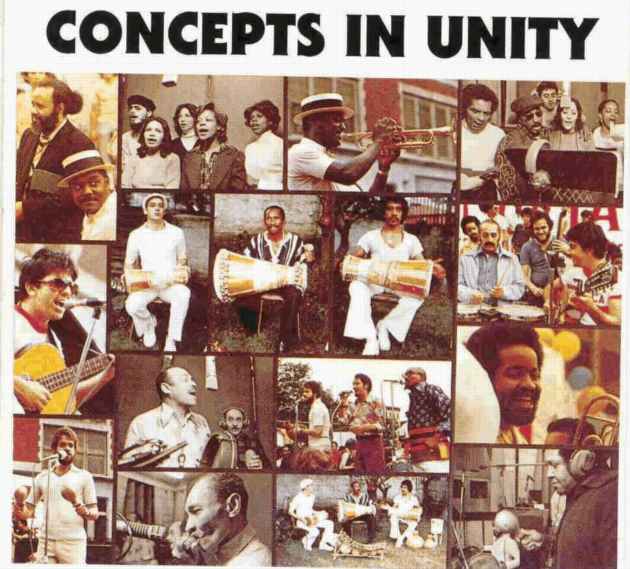 |
EEG: CFEN’s first album was very successful, and you recorded a second one.
AG: The first one came out when there was nothing like that happening. It had a lot of energy. The second album has some things like that, too.
EEG: After the second album, the CFEN kind of faded out. What happened?
AG: Well, we weren’t a steady working group, because everybody was involved in something else. Milton Cardona was playing with Willie Colón, we were playing with Libre…
EEG: Libre is my next question…
AG: Now, a lot of people say that Libre came out of GFEN. That’s not true. We started before GFEN.
EEG: When did Libre start? 1974?
AG: Yeah.
EEG: When did GFEN start?
AG: Around the same time.
EEG: OK. Tell about Libre’s origins.
AG: Well, we started our band because we wanted to play más salsa, more in the dance scene. But we wanted to play our style. We didn’t want to play what the style [of the moment] was… There was always some kind of thing going on…
EEG: Trumpets and trombones…
AG: Yeah, trumpets and trombones and all that stuff, and I didn’t care for that. I liked the trombone sound, I like trombones. And it was easy for me to write charts for trombones, because it’s at the same clave as the bass.
It was on the strength of the GFEN records that they (Salsoul) signed Libre. We produced it ourselves; it as the very first time that I was involved in total record production, from beginning to end, all the way to mastering. I did some mixing for the GFEN records, but my first “big” experience was with Libre.
EEG: Wasn’t Libre like a continuation of Eddie Palmieri’s La Perfecta —trombone-wise?
AG: No. We didn’t want to be like La Perfecta, because that was that. That was Eddie Palmieri’s sound at that time. But, when we started, I liked the sounds of the trombones, and it was easy for me to write the music. When we first started, it was one trumpet and two trombones. Then it changed, to just trombones —two trombones—, and then three trombones, and then four trombones! (LAUGHTER BY ANDY)
EEG: Do you recall Libre’s first gig?
AG: It was at the John Jay College [in Manhattan]. They were celebrating something in regards to Puerto Rico. I think it was about Puerto Rico’s discovery, and they celebrate it with a party every year. The John Jay is a college for policemen, of criminology. The boricuas in the college hired us to play there.
EEG: Who was Libre’s first singer?
AG: Carlos Santos. He sang the first gig with us. That was his only one. Willie García also sang only one gig with us.
EEG: Then came Pupy…
AG: Pupy Torres y Tempo Alomar. Tempo was first, and he brought Pupy to a rehearsal.
EEG: You told me once that you offered the position to Rubén Blades.
AG: Yes, there was a time that Rubén was working moving boxes at Fania, in New York. I invited him to my house, and he came with his guitar. We played and talked a little bit. I offered him a job, but he went with Ray Barretto instead.
EEG: What’s Libre’s official birthdate?
AG: Octubre 24, 1974. (18)
EEG: Libre has also gone through changes in the band’s name —Conjunto Libre, Libre, Manny Oquendo y Libre, etc. Why?
|
Conjunto Libre: E. Olivera, A. González and M. Oquendo. Photo by ©E. González |
AG: Well, we did a couple of things. First of all, the first record was named Libre. Period. But we used the name Conjunto Libre, and there were many bands at that time that were using that name —“Conjunto”—, like Conjunto Saoco, Conjunto Candela, and many others, and that created confusion. And Manny, who has always been the band’s director – the leader --, and I -- the co-leader and musical director--, decided to change the name to Manny Oquendo y Libre. But, at the beginning, so that people would know, we were Manny Oquendo y su Conjunto Libre. Afterwards, we eliminated the “Conjunto” part, because there was already el Conjunto Clásico, Conjunto Candela...
EEG: Let me clarify this: When you began, the band’s name was Conjunto Libre. However, your first album’s title was Libre, only.
AG: Yes, Libre only.
EEG: Who were Libre’s founding members?
AG: Manny and I were the founders. In the original group, there was Jerry [González], Oscar Hernández (piano)…
EEG: Tempo Alomar singing…
AG: No. At the beginning, and before we did our first recording, our first singer was Carlos Santos, who only lasted one gig.
EEG: And you also removed the trumpet.
AG: Yes. Jerry [González] was the trumpet, and the conga player was Milton Cardona. Cachete Maldonado also played a couple of gigs with us. And then Jerry played the congas.
EEG: How did you meet and became friend of Manny Oquendo?
AG: Well, I was a fan of Manny Oquendo since he used to work with Eddie Palmieri y la Perfecta. Remember I told you the first dance that I played with the Latin Jazz Quintet that we had? The top of the bill was the Tito Rodriguez Orchestra, Eddie Palmieri y la Perfecta, Joe Cuba Sextet, and a few other bands. I saw Eddie Palmieri’s La Perfecta for the first time in that dance, but I had been hearing the records already, and loved that band. And I loved to watch Manny Oquendo, Tommy López, and Barry Rogers play. So it was easy for me when it came time to join Eddie Palmieri’s band, because I knew the music already – I never had to look at a piece of music!
So, the last year that I was with Eddie Palmieri, Barry Rogers came back into the band -- he hadn’t been with the band a few years --, because me a Jerry were there. And then Manny came back to the band. And that was to me…We spent a good almost eight months to a year [together], [and] Manny was playing with the band.
Things started to go wrong with Eddie Palmieri’s band at the time; there were a lot of business problems, and Eddie couldn’t solve them —it was too much trouble.
EEG: I imagine that there was a lot of disorganization.
AG: Well, I mean, just a lot of problems. He owed a lot of money to the government; he owed money to everybody… He owed money to the band! Manny didn’t like that. Manny said, “Look, if you mess with me, and you mess with the money with me, I’m gone!” So Eddie was always, you know, like trying to take care of him (Manny), and make sure that he was all right. Went to Puerto Rico, no money, we were going to get kicked out of the hotel. All kinds of weird things were going on.
EEG: You know, when I interviewed Eddie Palmieri, I asked him to name his favorite percussion line-up. He answered: Manny Oquendo on bongós, Manny Oquendo on timbales, and Giovanni Hidalgo on congas. Palmieri always had the best percussion, yet it seems that Oquendo really made an impression.
AG: Ha! Well, yeah, because Manny was the best bongó player, and still is the best bongó player and the best timbalero that I ever knew. And I have been with him for 28 years!
EEG: What is that Oquendo has that you like? He is certainly not a “show-off,” in regards to speed…
AG: It’s not about speed…
EEG: …but belongs to the traditional típico school.
AG: Because it’s hard to play típico style. You have to really know your music, you have to really know sound! Tirando mil golpes doesn’t mean a thing. But, when you play in the context that he plays, he’s playing for the dancer, he’s playing para acompañar la música. He does very, very strong, mature things in music. To me, it’s very easy to play that fast-rolls and all that speedy stuff. It’s harder to play slower, it’s harder to play things… When he plays, he makes a statement. He just doesn’t play beats, he makes statements! And that’s the difference, you know. I don’t think that there are any timbaleros left around today that could play like that anymore. There used to be, but they died – Manny is the last of the Mohicans, man! He is the last guy that can play that style truthfully.
EEG: Who else comes to mind that can play that style?
AG: Well, among the Cubans, Ulpiano Díaz, who was one of Manny’s idols; he was timbalero for Fajardo and Arcaño in Cuba. Another one was Orquesta Aragón’s timbalero, Orestes Varona. And he was the greatest, man! He was the best supporting the music; the best, the best!
EEG: What about Uba Nieto?
AG: ¿Uba Nieto? Uba Nieto was another of Manny’s idols —he played with Machito. He really developed the timbales in the big band.
EEG: Libre was very popular when it came out in the seventies, and it has been kept alive through time, surviving the extended merengue and salsa monga years. You have been recording in despite of the hard times. What keeps Libre going?
AG: We had a following! It wasn’t a Fania All-Stars kind of following, but we had a following, and we used to work a lot. Our records made noise, you know. Maybe they didn’t sell in the numbers of the Fania records, because they (Fania) had a huge machinery, and they tried a lot of stuff to keep us from being sold and to keep us to being heard.
EEG: Did Fania try to sign Libre?
AG: Sure! They tried to sign us at the beginning, but I took the contract to the lawyer, and the lawyer laughed at me. He said, “If you sign this, you are signing your life away.” So we didn’t sign with them. And then Salsoul gave us a good contract.
EEG: How strong was Fania trying to shadow other people’s careers?
AG: A lot. They used to do a lot of maldades.
EEG: Like what?
AG: Well, they used to tell the DJs not to play us, or else they wouldn’t get new Fania products. They would pay [the DJs] off. Even the Sunday salsa radio show that we started, they got corrupted. Felipe Luciano didn’t do the show anymore, because he started doing TV, so he gave it to somebody else, and they bought that person out. The show changed from the Sunday salsa show in the evenings to the Sunday salsa show in the daytime, in the afternoon. All of the sudden, you heard less of the music that we brought to the radio station, like Cuban music and more educational stuff. And then they started playing more Fania product. So what we did was that we had other DJs on WKCR, and we used to do those radio shows, the educational thing that we were doing.
EEG: So payola was also prevalent in those years.
AG: But payola was different. It doesn’t have to be money. It could be, for example, that you are going to be the MC, or you get so many tickets for the next big concerts…
EEG: One famous salsa musician told me that they used to take drugs and prostitutes to the DJs, so they could get airtime.
AG: Oh, yeah! All kinds of things! They used to give you free plane tickets to go to Puerto Rico, to go here, to go there.
EEG: So I guess that you don’t miss those days.
AG: I’m not one to be nostalgic about things, you know. Hey, what I like is what is going on today, what I’m doing today is what most interests me, although I studied the history of music – all kinds of music – so much, and I’m a fan of “world music.” I like all kinds of music, all over the world. But the thing that I like most, is music closer to folklore.
EEG: I read somewhere that you use two types of basses: a Czech and an Ampeg baby bass. Tell me about them.
AG: Well, the Czech bass that I have is 103 years old, and I found it in a very famous jazz bass player’s house, and it [previously] belonged to a very famous jazz bass player. It belonged to Miroslav Vitous, who is from Czechoslovakia. And he sold me the bass, and I have had it for 30 years. The Ampeg baby bass, my father bought that one when I was 13 years old.
EEG: How many basses do you own these days, and which one is your favorite?
AG: Six. [My favorites] are a German bass that I play a lot in recordings these days, and one of my baby basses.
EEG: When do you use the baby bass and when the acoustic bass?
AG: I like the baby bass for percussion. If you noticed, when I play with Fort Apache [Band] in “Calle 54,” I’m using the wood bass. And, if you noticed, when I play with Papato and Puntilla, I’m using the baby bass, because that’s better for percussion.
EEG: It gives you more power…
AG: Yes.
EEG: I read that you were friends with the late, great Jaco Pastorius. (8)
AG: Yeah. Jaco was already out of [the band] Weather Report by now, and he was playing on his own, he had his own band. Jerry [González] was playing percussion with his band. And then, Jaco was a fan of mine —I never knew that, but he was!—, and he told Jerry to bring me down. So I came down to one of the gigs one day, and I played bass with him.
I think that he was a genius. It’s a shame that he was a manic-depressive. He really needed to take Lithium, and he wouldn’t take it, and he would go crazy. But, you know, they say that about a lot of geniuses. He was a genius musician.
EEG: I read that he was also a fan of Libre. Did he ever share the stage with your group?
AG: Sure! He came and played with us! He was such a sweetheart. When it was Libre’s tenth anniversary, we celebrated at the Corso. He came to the gig! He came to the gig, and took all the money out of his pocket and bought two bottles of champagne to give to the band.
EEG: Were you good friends?
AG: Not real close, close friends, but we were very friendly. Jerry was closer to him.
EEG: OK. Please tell me about the origins of the Fort Apache Band.
AG: We started playing in a place called Newrican Village. Libre played there, the first bands that came from Cuba played there… The things that became Fort Apache started there – the music, the style. “Ya yo me curé,” that was totally Newrican Village.
We were always playing Latin jazz. We were hired to play in the Berlin Jazz Festival, and Manny Oquendo and Libre was also there. We played in the same festival, on different nights.
EEG: Do you remember the year?
AG: 1977 – 1978.
EEG: Who decided to call the group The Fort Apache Band?
|
|
|
|
AG: Jerry, because at the time there was a movie that came out, “Fort Apache, the Bronx,” with Paul Newman. It showed Puerto Ricans in a very, very bad light, nothing but junkies, drug addicts, putas, and all that. It was stereotyped, with things that would never happen in real life, like the junkie nurse – a Puerto Rican junkie nurse. You know, that stuff just doesn’t happen. The part about the police throwing people off the roof and stuff like that, that really happened, that was true. The police were motherfuckers in those days. We wanted to show that art still comes out of Fort Apache. That’s why we named the band “Fort Apache Band.” That element wasn’t the only thing happening in the Bronx – there were all kinds of artists living there.
We took the people from “Calle 54” there; they wanted to see Fort Apache. So I took them around, I showed them the area. They put it in the movie.
EEG: So what motivated the creation of the Fort Apache Band?
AG: We were protesting against the Fort Apache movie. It came about because of that.
EEG: I can never get enough of the Fort Apache Band. I usually tell people that Latin Jazz is divided into two groups: Before and After the Fort Apache Band. What is the concept behind your music?
AG: What it became, because it was an evolving thing… The first Fort Apache Band had more percussion; we had a lot of extra percussion.
EEG: “Ya yo me curé” is strong evidence of that.
AG: Yeah. So, what happened was that it just became very difficult to financially keep a large ensemble like that happening. It was much easier for a smaller group, so Fort Apache became a quintet. And that, to me, is the best thing that we ever did, because it gives us more room to [experiment]. It used to be a sextet; our sort of a model was the Miles Davis sextet. He had “Cannonball” Adderley and Coltrane. Miles Davis has a lot to do with the style of Fort Apache, because we were big Miles Davis fans, and we used to go see him play all the time.
EEG: Did you ever interact with him?
AG: Sure! We opened for Miles Davis! That was in the late eighties, in a jazz festival in France. That was because Miles Davis one time heard us, he listened to us, and, after our set, he goes to [pianist] Larry Willis, and he says, (IMITATES MILES DAVIS VOICE) “You guys are playing my shit… Sounds good!” (LAUGHTER BY ANDY AND ERIC) He saw us play a few times, and he always liked what we did.
EEG: How did Fort Apache member Carter Jefferson die?
AG: Well, he used to [do] drugs, but he didn’t die from that. He died from some kind of infection of the liver or something like that.
EEG: At that time the Fort Apache had one trumpet and two saxophones. Did you decide to get rid of one sax after Carter’s death?
AG: No. Then we got John Stubblefield, who took over on the tenor.
EEG: When did you decide to eliminate one sax from the lineup?
AAG: After the “Pensativo” record. Then we went to a quintet.
EEG: Have people complained about the change?
AG: No, because we have such a great alto sax player —Joe Ford—, he’s a genius.
EEG: I read a quote once, I believe by Horacio “El Negro” Hernández, in which he said that not every drummer can sit down with the Fort Apache Band. That’s a huge compliment.
AG: It’s true! You have to know jazz well, and you have to know afrocuban music well. You have to know both worlds, and that’s very difficult. Not everybody can do that.
EEG: “Rumba para Monk” is hailed by critics as Fort Apache’s best recording to date. Is that your favorite, too?
AG: No, [but] that’s a good one! It’s probably my second favorite. I like “Moliendo Café.”
EEG: What about Libre?
AG: I like the new one.
EEG: “Los New Yorkiños!”? OK, let’s take a minute about this one. Libre made a “Live” recording with almost the same tunes that are included in “Los New Yorkiños!,” the only difference being that Jorge Maldonado is the lead singer of the later one. What happened there?
|
AG: I’ll tell you. The material (“Los New Yorkiños!”) was recorded ten years ago, and it was never released. EEG: Who was the singer then? AG: Hermán Olivera. But Hermán was no longer with us. He left us to go with Eddie Palmieri, and we didn’t like that. We weren’t going to put out another record of Libre with Hermán’s voice on it, if he wasn’t going to be with us – it didn’t make any sense. Jorge [Maldonado] was the singer with us, so we put his voice on it. |
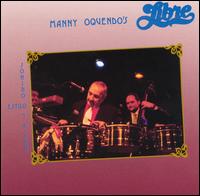 |
EEG: What about Frankie Vásquez?
AG: Frankie was now with Los Soneros del Barrio.
EEG: So Jorge is your singer these days. How long has he been with Libre?
AG: He’s been there for two years already.
EEG: Has he adapted well to Libre? The Olivera – Vásquez combination was really good.
AG: He is the best singer that we ever had – the best! By far the best, and the most mature!
EEG: Libre is also going through some changes. In “Los New Yorkiños,” you added new elements.
AG: That was ten years ago!
EEG: You added a guitar. Do you still have it?
AG: Yeah. The guitarist (Octavio Kotan) is still with us.
EEG: What about the trumpet (Alex Norris)?
AG: No. We did some overdubs on that record. We added a trumpet, we added bongó on certain tunes that didn’t have it, and we added the guitar. We added a couple of things, and then we remixed it. And we changed the voice (from Olivera to Maldonado).
EEG: Another Libre album with a strange background is “Ahora,” which has been released two times, with different labels.
AG: This (“Los New Yorkiños!”) was the second volume of “Ahora.” We recorded [them] at the same time. If you look at the personnel of “Ahora” and look at the personnel of “Los New Yorkiños!” is the same people, except we changed singers, and we added the guitar. And we added Xiomara [Lougart] on vocals.
EEG: What about the hip-hop?
AG: No. That was done ten years ago. A hip-hop guy (El Cacique) came and sat in with us, and we liked what he did. They didn’t do it exactly the way that I had it planned, tough. The way the record begins, “New Yorkiños, venimos de las nubes…” it was supposed to start with thunder and lighting, like a storm. But the producer didn’t obey my instructions. I said, “I want thunder and lighting at the beginning of the record,” (IMITATES STORM NOISES) you know, to make it sound like we are coming out of the sky: “New Yorkiños, venimos de las nubes…” And it didn’t happen. (LAUGHTER BY ANDY) I was so angry when I heard the test. I said, “Wait a second. Where are the thunder and the lighting?” [And the producer said:] “Oh, I forgot.” (LAUGHTER BY ANDY AND ERIC)
EEG: Wow, you guys were ahead of the times. However, with few exceptions, Libre has been very strict in regards to change. What made you add the guitar and the trumpet permanently?
AG: Because we had them in the band already, and we wanted the record to reflect a little bit on how we sound like right now. If you listen to our first album, there is a baritone sax on “Donna Lee,” and there is a baritone sax on the second album, and there is a baritone sax on “Mejor que nunca.” Ronnie Cuber played the baritone on those two cuts. In “Mejor que Nunca” it was Alex Harding, who was with the band for a little while at that time. We try to keep an open mind on things, you know, experiment. (9)
EEG: Your first version of “Ahora” came on the Amo label.
AG: That’s because we put our own money, and we recorded it ourselves. We didn’t have a company to record us.
EEG: And how come it came out again under the Milestone label?
AG: Because they bought the masters. They bought the masters of “Los New Yorkiños,” and they bought the masters of “Ahora” – both of them.
EEG: Was “Los New Yorkiños” meant to be released on the Amo label, too?
AG: Yeah.
EEG: Jerry and you have collaborated with a very special musician named Kip Hanrahan in many of his projects for his American Clavé label. The most known of these recordings are the two excellent “Deep Rumba” volumes. What can you tell me about Hanrahan and your relationship with him?
AG: OK. Kip Hanrahan was the producer of Jerry’s first record -- “Ya yo me curé” --, and he got that money from a car accident he was in. He was in a car accident, and with the settlement money that he got from it, he started his record company, and he recorded “Ya yo me curé.” He is a very eclectic, very, very smart guy, very knowledgeable about music and styles. He was an apprentice in filmmaking to Jean-Luc Godard. The guy has been around, you know. But he wanted to start a record label and record the music that he liked, so that’s how he got to do “Ya yo me curé.”
EEG: Both “Deep Rumba,” as well as Kip Hanrahan’s own recordings are a mixture of so many things – jazz, blues, rap, poetry, salsa, Latin Jazz, Rumba… Somewhere in that salad, there is order. Does he have a master plan when he does his albums?
AG: There is a master plan, and sometimes there is music, and we play, and then he becomes like a movie director. You saw the movie “Piñero”? Kip Hanrahan did the soundtrack. Me and Jerry are all over the place in the soundtrack of that movie. There is “Deep Rumba” music in “Piñero”! Not only that -- I’m in the movie! Miguel Piñero, that was the same time as the Newrican Village, although they don’t go into anything about the Newrican Village.
EEG: Did you know Piñero? Tell me about him.
AG: Sure. He was a junkie and a crazy nut, but he was a writer, and his “Short Eyes” hit it big, and he became a bigger junkie.
EEG: Was he into Latin music?
AG: He was into it, but he was more involved in writing and poetry – that was his thing. He used to come and see us play. And then, Tito Goya – not his real name --, his partner in crime, was Libre’s band boy for a while. He grew up in the eastside. He looked like a Latino, but he wasn’t. He made some movies! He was in “Marathon Man,” with Dustin Hoffman. He played the guy that called Hoffman “El Loco.” He was also in “Short Eyes,” from Piñero’s novel. Tito Goya played the part of “Cupcakes.” (LAUGHTER BY ERIC)
EEG: You were also in another movie: “Crossover dreams,” with Rubén Blades.
AG: Libre was in the movie!
EEG: And Virgilio Martí.
AG: Virgilio Martí, from the Grupo Folklórico Experimental.
EEG: Who chose you to be in the film?
AG: León Ichaso (the director). He had been talking to me about Piñero for years, and he told me that, when he was going to do the movie, he was going to call us to be in it, and to be in the soundtrack.
EEG: Rubén Blades was the star of “Crossover Dreams.” As far as I know, you only played in one of his recordings, “Canciones del Solar de Los Aburridos.”
AG: Yeah.
EEG: I thought that your bass was very effective in that album. How come you didn’t do more albums with him?
AG: Because I was busy with what I was doing, and he was busy doing his Willie Colón stuff. You know, when Rubén Blades first came to New York, I offered him a job with Libre. He came to my house with his guitar, and spent the day with me.
EEG: Was he already working for Fania?.
AG: He was working in the Fania mailroom -- mailroom shit, carrying boxes…
EEG: Did he decline the offer to work with Libre?
AG: No. I think that [Ray] Barreto offered him a gig, and then he decided to do that. But I had offered him a gig.
|
|
|
EEG: One of your projects with American Clavé was recording with tango great, Astor Piazzolla. How did that happen?
AG: That happened with Kip Hanrahan. Astor needed a bass player for a recording session, and they asked me to play. I was a fan of Astor, I have music of his. I listened closely, and I said, “OK, I know what to expect.” So I went, and, you know, that’s one of the feathers in my career – my cap, so to speak, getting to record for Astor Piazzolla.
EEG: What can you tell me about him?
AG: Very exacting. Nice man, but very, very precise about how he wanted his music played.
EEG: I believe that you only did “Tango Apasionado” with him.
AG: Ah! Wrong! I did his very last recording. He had an Argentinean bass player, who had arthritis in his fingers, and couldn’t play. And he played very badly, so I re-recorded the bass parts. It wasn’t the guy that plays in his band; it was somebody else. [Astor] was very ill in the hospital, and that was his last recording. (10)
EEG: How comfortable is for you to play tango? Was there a lot of improvisation?
AG: Very [comfortable]. You know who improvises in the tango? The bandoneón, and sometimes the piano, and that’s it. Everybody else just follows the music; it’s written out. In Astor Piazzolla’s music, every note is written out.
EEG: How come Jerry only recorded one album with American Clavé?
AG: But we recorded a lot for him (Hanrahan) over the years on his records. I still work for him; I did “Deep Rumba.” We have been to Japan a couple of times, France, Holland… we travel – one of the many things I got to do. “Ya yo me curé” was American Clavé’s very first record. That made noise, but he (Hanrahan) didn’t have the contacts, sales, and all that. So, I mean, whoever wanted to record us, could record us. That’s how we got to record “The River is Deep” for Enja Records, which is a German label. Then we started recording for Sunnyside records, you see, and then we went to Milestone. And then we did another Enja record!
EEG: Right now you are with Milestone.
AG: Right now we are open, we don’t have a label.
EEG: You are not with Milestone anymore? You were supposed to release a second volume of the live Fort Apache album.
AG: Yes, there is a second album. But they haven’t released it – I don’t know why, it’s a good record.
EEG: But Libre is still with Milestone, No?
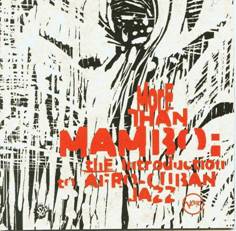 |
AG: No. They just don’t know how to market us. All they know how to market is jazz. Milestone / Fantasy, their expertise is releasing old product that they own. They own a lot of old jazz labels, and they make a lot of money just releasing the old records, over and over. The majority of their money, they make that way. Now, the few items that they still record now, they don’t promote them, and they don’t put money into promotion. When we signed with them, they put out our records, and they didn’t know how to market us. They didn’t know what category to put us in, and they didn’t know anything about the salsa market. |
EEG: It’s a powerful company…
AG: Yes, they are a huge company, but they don’t know how to market anything Latino. They didn’t know what to do with Libre! They didn’t know what to do with Fort Apache, either.
EEG: You also played with the late great Jorge Dalto, and recorded with him and his Orquesta Interamericana.
AG: A little bit, yeah. I wasn’t there very long, but I did play some gigs, and I recorded a couple of tunes. Jorge was a sweetheart, another genius piano player. He died of lymphoma. Very sad.
EEG: OK. Let’s talk about your current projects. Let’s begin with Rumba Club.
AG: I was teaching the bass player in that band, I was giving him lessons. And then, when they decided that they wanted to make a record —they would put their own money and make a record—, they called me to produce it. I said, “Sure! I can produce it.” So I produced the first one for them. Then, they got a record company to pick them up, and I do all their productions – four records now. Tim Murphy is a great piano player.
EEG: Libre’s trumpet player was part of that band, too.
AG: Oh, yeah! Alex Norris! Alex was the original trumpet player in that band -- that’s how I found him, in Rumba Club.
EEG: You also recorded “Pure Emotion” with the late great Chico O’Farrill…
AG: I recorded all the records with Chico O’Farrill.
EEG: I guess that you are referring to the ones that he recorded with Milestone. Right?
AG: Yeah. I was the one that was responsible to get Chico O’Farrill in Milestone Records.
EEG: Because you were a Milestone Records artist.
AG: Yeah, with [producer] Todd Barkan. I was doing a Chico O’Farrill jingle, and I invited Todd Barkan to come and meet Chico O’Farrill.
EEG: Todd Barkan has also been your producer with Libre. How’s he as a producer for salsa music and Latin jazz?
AG: He’s not a salsa producer, and he is not a Latin jazz producer. He is a jazz producer, and that’s his best forte. When he put his name on the Libre records, I was upset, because we did all the production work.
EEG: Tell me about Chico O’Farrill, whom I was also fortunate to meet.
AG: Wonderful man. Very, very insistent upon his music being played correctly, but also open to ideas. He used to leave the bass player alone, and I had to come up with a lot of the bass ideas. But it’s good that way, I like it, I prefer it that way.
EEG: You played with both Eddie and Charlie Palmieri. What are the differences between them?
AG: Eddie got closer to the real Cuban school of piano playing, and Charlie was more in the school of Joe Loco and Noro Morales. Charlie comes out of that school.
EEG: I understand that you want to work on a project called “Strings Attached.”
AG: It’s an all-string band, all kinds of strings – guitars, violin cellos… everything! It’s going to have percussion, but the basic sounds are strings.
EEG: Can you give me a source of reference to compare it with?
AG: Think Jíbaro music from Puerto Rico, think of hillbilly music with banjos and guitars from the United States.
EEG: What is the status of that project?
AG: Well, I haven’t done anything with them, yet. But I have another project that I’m doing, that nobody knows about. It’s called Latin Jazz Lab. (11)
EEG: What is the concept behind that project?
AG: Whatever I want, whatever I want to do – it’s open. But right now it’s a just a quartet – a bass, guitar, congas, and trumpet.
EEG: Have you done any gigs yet?
AG: Yeah. Me, Edgardo Miranda on guitar and cuatro, Alex Norris on trumpet, and Tony Rosa on congas. (12)
EEG: You also played with Daniel Ponce in his “Arawe” album. Care to talk about it?
AG: I don’t.
EEG: He kind of disappeared from the map.
AG: Yes, for good reason. (LAUGHS)
EEG: Why was that?
AG: Because he burned his bridges in New York. He made enemies with everybody in New York; nobody likes that guy.
EEG: Tell me about Hilton Ruiz, who recorded with Fort Apache in its origins.
AG: A friend of mine for many years. We involved him with Latin jazz. He wasn’t playing Latin jazz; he was playing straight-ahead jazz. So we sort of brought him into the world of Latin jazz. Hilton wasn’t with us steady. He was just playing with us at the time in the Newrican Village. I played with him, too, in his group. That first record, “Ya yo me cure,” wasn’t a steady group. It was just friends getting together.
EEG: How did you get Larry Willis, the current Fort Apache pianist?
We knew Larry Willis from before. First time we played together was in jazz club called “Bradley’s.” That was a very famous piano and bass bar. But we brought in our little Latin jazz thing, with Larry Willis, me on the bass, and Jerry on the congas and the trumpet. It was the first time that we played together, and it was so good, and that’s why we decided to have him play in the Fort Apache Band.
EEG: What about Steve Turre, who recorded with Libre?
AG: Another person that we brought into our world. And now I play with him with his shell band. He has a band with just shells, and I worked with that band a few times. The four albums that he has done, I play on them. (13)
EEG: I noticed that he has a lot of respect for Libre. He always includes some of the Libre members in at least one tune of his albums, usually a descarga a la Libre.
AG: Yeah, because we featured him quite a bit, when he was playing with us, and he got to be known in the Latin world through us.
EEG: Totico y sus Rumberos. Was that a product of Grupo Folkórico Experimental?
AG: Yes, that was one of René López’ productions. That was nice; we did a few interesting things there. That was the first album that Puntilla sang on.
EEG: Orlando “Puntilla” Ríos is not very well-known in the commercial world. He’s getting more exposure now.
AG: He’s been around. He came with the “marielitos.” As a matter of fact, he made his first presentation with Libre, and so did Daniel Ponce. We have always been helping people out like that, you know.
EEG: Puntilla is also very prominent in Kip Hanrahan’s albums. (14)
AG: Yeah. See, Puntilla is one of the few people that are heavy in the religion. He does more work outside of regular… You know, Kip Hanrahan, his main thing is to sing and play batá and santo music, santería.
EEG: Totico also did an album with Patato.
AG: That was one of the first guaguancó records that was done after a long period of time that nobody had done any percussion records. Cachao and Arsenio Rodríguez play in that record.
EEG: I really enjoy Willie García’s singing in some of those projects, particularly with the Conjunto Folklórico.
AG: Willie García se volvió loco long time ago. He was married to La Lupe.
EEG: Maybe La Lupe made him crazy. (LAUGHTER BY ANDY AND ERIC)
AG: That’s what I always thought. (LAUGHTER BY ANDY AND ERIC)
EEG: So he’s really crazy.
AG: Está “tostao,” el pobre. You know, he made a record with Charlie Santiago. It’s a record that René López produced. It’s Charlie Santiago y su Charanga, and it’s called “Son Primero.” That’s Willie García singing there. El estaba “tostao” y cantó bien, bien, bien en ese disco.
EEG: Now that you mentioned La Lupe. Did you ever play with her?
AG: Yes. I backed her show many times. I recorded albums with her.
EEG: Really? Do you remember which ones?
AG: I don’t remember. (15)
EEG: What can you tell me about her?
AG: She was nice; she was kind of nuts, too. But everybody says that she was a drug addict. She wasn’t. She was [into santería], but then she got into Pentecostal afterwards. I didn’t even recognize her the last time that I saw her.
EEG: Did you ever see her performing her famous semi-strip shows?
AG: The most that she ever did… I remember the first time that I saw her, she was wearing a skirt and a t-shirt, with a sequence sawn into it, and she wouldn’t wear any bra. I was a teenager, you know, I was in the audience, and she was with Tito Puente at the time. She would be lifting her t-shirt up, to show her tits… but real quick! Just a quick flash, you know. (LAUGHTER BY ERIC)
EEG: Of all the female afrocuban music singers – Celia, Graciela, La Lupe, and others, who’s your favorite?
AG: I like Celia when she was with la Sonora [Matancera] in the fifties. I thought that that was her greatest period. I don’t think she’ll ever top that. I have live recordings of her on the radio in Cuba, con la Sonora Matancera --- tremendous! I like Graciela a lot – she was a swinger. I heard her sing many times with Machito. I played with Machito, and she was still there. Right now my favorite bolero female singer is Xiomara Lougart.
EEG: You also participated in David Byrne’s “Rei Momo.” How did you get involved in that project?
AG: Well, somebody recommended me. They needed a good Latin bass player, and they recommended me for the project, so I did it. They had a world tour, and I didn’t go. And lucky thing that I didn’t go, because that was the time that we decided to record [Libre’s] “Ahora.”
EEG: Did Byrne allowed some input from you in his project?
AG: We experimented a bit, and he accepted my ideas when I gave them.
EEG: You were also part of Tito Puente’s Latin Jazz Golden All-Stars. You recorded in their first CD, which was “live.” What can you tell me about this experience?
AG: I was a member of that group since the beginning. Jack Hooke started the idea, and I was member of that band up until Tito died. The only appearance that I missed was in “Calle 54.” I was supposed to play the bass with Tito Puente in that movie, but I had to go out of town with Fort Apache, when they were filming the Tito Puente segment.
EEG: But, still, you are all over that movie.
AG: I know! Yeah. (LAUGHTER BY ANDY AND ERIC)
EEG: What can you tell me about Puente as a leader?
AG: I heard that he was a tough guy -- not tough, but very arrogant --, very self-centered, and jealous, like he didn’t want anybody to shine on the bandstand better than him. And that’s why in the early years, when he had his conjunto, he used to put Vicentico Valdés in the back, and he used to stand in the front of the band. There are photos at the Palladium to prove it, when Manny [Oquendo] was playing with the band. But he mellowed out by the time I got to play with him. And he had great respect for me, because he knew that I knew about the music, and that I studied the history. As a matter of fact, when he couldn’t remember something, he would always ask me, “Hey, What was this year and this recording?” and I would tell him. We got along good; he was never nasty to me, like I heard that he used to be.
EEG: Víctor Paz told me that Puente would get angry if he tried to do a solo. The show was about Tito, only.
AG: Yeah, because he was the star of the band, and he didn’t want anybody else to be the star. But, like I said, with me, and the Golden men, he didn’t have to do anything there, and everybody was a star. He had Giovanni [Hidalgo] playing, Mongo playing… Everybody in the band was a leader or a star, so we would just relax and had a good time.
EEG: Tell me about the CD that you did with trombonist Conrad Herwig.
AG: I only recorded two tracks, and they cut part of one. So I don’t know what to say about that. The Coltrane album— “The Latin Side of John Coltrane”—, I didn’t care for that idea too much. (16)
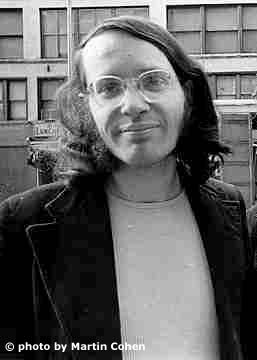 |
EEG:
Libre has had the who’s
who in trombone playing. Whose style do you like more: Conrad Herwig or
Barry Rogers? AG: Barry! Barry all the way. Barry was a student. He studied all the Cuban music – faithfully! And he knew it. He learned it from Manny Oquendo. Manny Oquendo taught him, taught Eddie, taught a lot of people about the music. EEG: Many people place him as the best trombone in salsa music ever. AG: To me, he was the most individual, he had a true individual sound. He had his own sound, he had his own style, and he played in clave. I remembered that he played with me many times, and we played with Libre many times. Man, he was just a great musician. He was a sweetheart, a beautiful person. EEG: Víctor Paz told me that Barry used to carry a jar with some green stuff that he used to eat. Do you know what it was? |
AG: No, but he was a vegetarian – I know that. But there was one thing that I knew: I used to see him tune the piano before Eddie Palmieri would play.
EEG: Yeah. Eddie told me that Barry would be tuning up the piano, and many times the crowd was impatiently waiting for the show to start. Imagine that tension!
AG: Sure, because the piano would be all fucked up. He was an amazing man, an amazing person.
EEG: Did they ever find out how Barry died? He was still young.
AG: No. He just died in his sleep, naturally, from no disease. Did you know that I made a record with Tito Rodriguez?
EEG: Nope. Tell me about it.
|
|
|
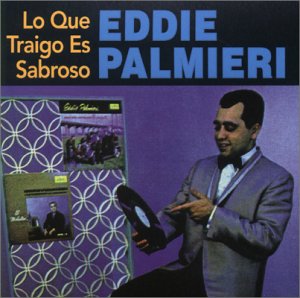 |
AG: One time I was playing with Eddie Palmieri, and Tito Rodriguez was in the same dance, accompanied by Machito. The bass player was Julio Andino, and he had arthritis in his hand, so he couldn’t play the show -- the Tito Rodriguez show --, even tough he was the bass player of Tito Rodriguez in the fifties. But he was having trouble. So they asked me – I was playing with Palmieri --, to just play the show for Tito Rodriguez with Machito, without ever having seen the music or rehearsing it. I side read it, and I did a good job. And he decided to use me in his next recording, which was just in a few days. It was the record that he did with Louis Ramírez, “Algo Nuevo” – Tito Rodriguez and Louie Ramírez. You know what I like the most of that record? The arrangements that were not done by Louie Ramírez. It’s the boleros, which were arranged by Arty Azenzer.
That record doesn’t have the credits, but that was my only recording with Tito Rodríguez —a feather in my cap. (17)
EEG: You also recorded in Machito’s “Fireworks.”
AG: “Fireworks,” yeah. I worked with Machito’s band a bunch of times, a whole lot of times. I wasn’t a steady there, but I would substitute for the bass player a lot. He was a wonderful person, man. His family, they were nice people.
EEG: And Mario Bauzá?
AG: Mario Bauzá was a great person. When they (Machito) split up, he started his own band, and I never worked with that band. Joe Santiago had that chore, you know.
EEG: You were a player in Charlie Palmieri’s “Impulse.”
AG: I used to work with Charlie, too. But Charlie, in his last years —he already had a heart attack —, he wasn’t supposed to be drinking and smoking, and he would still do it. And I used to tell him, “Why are you still doing it?” And he said, “Look, I want to live my life the way I like to live it, and if I have to stop all the things that I like to do, then that’s not living my life. I’m going to live it the way I’m living it, y que se jodan.”
EEG: Lets talk about Patato. You worked in “Masterpiece,” which it is said was released ten years after it was recorded. Do you know the story of this album?
AG: Jorge Dalto was producing that record for Patato, and then Jorge got sick and he couldn’t even finish playing on it. There was one tune that he didn’t play, and he had Michel Camilo play in his place. I like that record because it provided me with an opportunity to record with Vicentico Valdéz. I have been fortunate that in my career I have been able to record with a lot of great singers —Bobby Capó, Vicentico, Santitos Colón, Graciela, Gilberto Monroig… I wish I could have recorded with my favorite male singer of all times: Lucho Gatica. I have one record of his, which is my favorite record of all. It’s called “Exitos con Lucho”; it’s just him with a guitar, a bass, a little bit of rhythm, and that’s all.
EEG: And that’s your favorite album of all times.
AG: Of all times! That record should win Grammys, hall of fame… everything! Lucho Gatica is my favorite bolero singer of all times.
EEG: So why did Patato’s album come out ten years later?
AG: Because there was a lawsuit. Patato had a lawsuit against the record company. So, until they solved that problem, they couldn’t put that record out.
EEG: You also recorded with the late Kenny Kirkland.
AG: Kenny Kirkland was a sweetheart, a genius piano player, and he died too young. And he played with Fort Apache, too!
EEG: What about Papo Vásquez, who was a founding member of Libre?
AG: Papo Vásquez is a genius trombone player. He was a member of Libre; he was sixteen years old.
EEG: You also recorded with the great Ismael Rivera.
AG: I worked in his band Los Cachimbos. He was a great singer, a great person. Wonderful. [I wasn’t with Ismael] that long. Whenever he needed a bass player, and I was available, I would do it.
EEG: You have been around for a long time, since the sixties. Which period do you think you accomplished most?
AG: I think that in the eighties we accomplished a lot, in everything that we did. I think my best effort is yet to come.
EEG: Tell me about the state of the music in the nineties. How did it affect you?
AG: Well, yes, it did affect us. I mean, it started in the eighties, too. We didn’t record for nine years with Libre, because no company was interested. Everybody was salsa monga, salsa romántica, or merengue. It didn’t stop us from working, but it stopped us from recording for a while.
EEG: What problems do you see with today’s record companies?
AG: Most record companies’ people are not musicians, don’t know anything about music, and they are not creative at all. They are not ready to back anybody that has new ideas. They want to go with something that has been tried and true; somebody makes a hit, they want to copy it. They want to copy the sound, the style, the production values, everything. They are very reluctant to take a chance on something new. And that’s the worst thing that can happen in our business, because the ones that come up with new things, are the ones that triumph.
EEG: After the Buena Vista Social Club phenomenon, there have been some changes. It seems that the good music is coming back.
AG: Yeah, I know, it’s coming back, but it’s coming back in a way that… There was a whole era of music that had great artistry to it, and I don’t see that coming back too soon. I’m talking about the fifties and the sixties artistry. Great art! Great artists! Chucho Valdés is a great piano player, but him, Michel Camilo… all the guys in “Calle 54,” everybody was gymnastics! “Pianistic” gymnastics! And, to me, that’s not art. That’s just showing off. I call it the “Look, man, no hand! Syndrome.” In other words, “I can do this, I can play higher that anybody, I can play a million notes without breathing.” All that means nothing. In music, the artistry that I’m talking about is honest, it’s not about showing off. It’s about sending a feeling of communication of the music that you are playing, the feeling of what you are trying to convey. There is something special about true artistry.
EEG: Reminds me of Gonzalo Rubalcaba, who has been criticized for his speedy piano.
AG: Same. Music has to have a lot of elements for me to be interested. It can’t be just one thing. It can’t just be speed and technique. It’s got to be air, space, emotion… It’s got to have a lot of things in it for me to like it.
EEG: What do you think of the new talent in the afrocuban music environment?
AG: I feel that a lot of them haven’t really matured.
EEG: Compared to the Palladium years and the Fania years, How do you see afrocuban music in New York City these days?
AG: Terrible. New York is dying. To me, New York was the hippest place on earth. Now it has become a hick town. I mean, not just rednecks, but just the demographics of things. Now, a lot of the original Puerto Rican population, they are moving out into the country. They are moving away from New York City. And the ones that are there are not really putting any emphasis on culture and maintaining their culture. They are turning into anglos. And then, the new generation of Latinos, they are going straight into rap. They are not involving themselves in any kind of culture that has to do with our culture. Also, there is a large, large population of Mexicans, and a large population of Dominicans now, and they are pushing their music. So afrocuban music or Mambo in New York, all that is getting pushed aside.
EEG: Being a student of music, What do think of the new wave of music coming out of Cuba?
AG: Timba, I’m tired of it already. And I’m tired of musicians playing a lot of notes, and not having any feeling behind it.
EEG: I believe that Tito Puente once said that the day that the Cubans came out again, the musicians in New York would have to go back to school. Do you think that is true?
AG: No. The Cubans are doing the same…They are just following the trends, just like everybody else. They are doing rap in Spanish, they are doing hip-hop. And then they realized that the Buena Vista Social Club sold five million records -- more than any of the contemporary Cuban bands --, so now all the contemporary Cuban bands are having to take a step back, and re-visit old roots, which they never grew up with. They did not grow up listening to that music, so for them to play it…They are not listening to the artistry of it. I think we have more expertise playing old Cuban music in New York than they do, because of the traditions that we kept alive – because we did do that. There are people here that can still play that music with more authenticity.
Younger musicians, they want to play the way they want to play, and some of it is a little too crazy. They want to be the next virtuoso. Nobody is speaking about playing as a team, playing together to accompany the music, to accompany the arrangements, to accompany the singer. They just want to tirar mil golpes.
EEG: Many of them – if not all – are very academic, because they attend good music schools at the island. Yet, sometimes you don’t feel a passion.
AG: Right! They come out, and they can read well, they can play well, but there no feeling! There is no feeling! I don’t feel it! I’m tired of hearing trumpets that sound like mariachi trumpets! I’m tired of that, man! Not that they sound like mariachi trumpets, because there is some good in that, too. But sometimes is overdone (IMITATES THE SOUND OF THE TRUMPETS), with phony bravados. A lot of trumpet players try to copy Arturo Sandoval, and I don’t think that’s a good idea!
Hey! I don’t care what instrument. I just want to hear it played well, nice, you know. And I don’t want to hear a stereotype. I want to hear originality. And Cuban music was total original artistry, all [the way] through the fifties.
EEG: OK, Andy, we have reached an end to this great interview. Any closing thoughts?
AG: I spend plenty time teaching. I teach the youth, and I continue to teach. I try to guide them in a more honest approach to music. I try to just be honest and play pretty music. And that’s the best that I can do to help anybody get along, and to help culture get along. But, I don’t know how far is going to get, and I don’t know where it will go. I still have hope.
An important closing statement by Andy González:
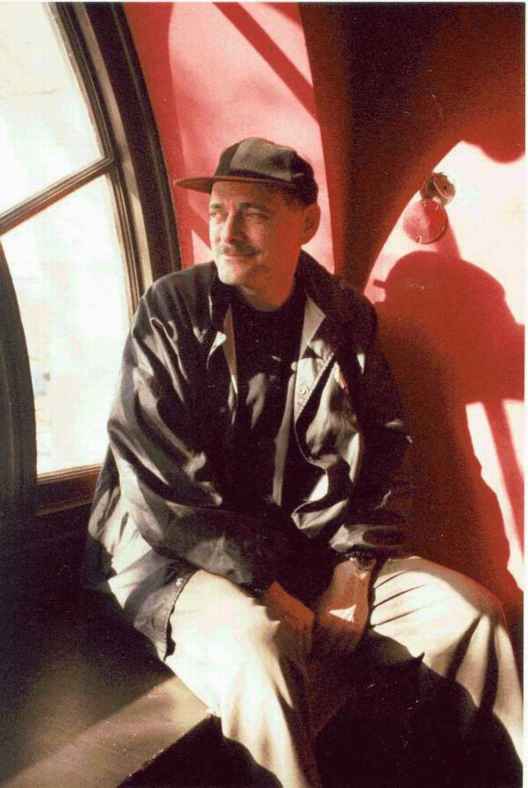 |
The interview that you just read was recorded in 2002. Since December, 2003, Andy has been having health problems caused by unchecked diabetes. As of April, 2004, he lost five toes in one foot. However, like a good warrior that he is, he is slowly recovering and hopefully will be back in action real soon. On April 25, 2004, I asked Andy about his disease and this is what he had to say: “Well, for the last ten years, without knowing it, I have been diabetic. I didn’t know, and I didn’t go to the doctor. So my advice to everybody is that, if you feel sluggish, or you don’t feel right, or you feel certain symptoms, you go to the doctor! My problem was that I didn’t go to the doctor – I was too busy, and I let my foot get infected, and it got gangrened, so they had to cut part of it off. But I do have half of the foot, I have my heel, so they are going to fit me with a prosthetic shoe, and I will be able to work normal.
I lost three toes in my left foot. Then I had an accident that wasn’t my fault; it was caused by some [persons] that were taking me in an ambulance to see my surgeon for a checkup. It caused me to loose my other two toes. The infection is gone, I’m on a strict diabetic diet, my blood sugar is in control, the wound to my foot is healed, and, in the next two weeks, they are going to fit me with a shoe. I am doing exercise, I’m doing therapy, and I will be walking soon.” |
NOTES:
(1) The double-CD named “More Than Mambo” was released in 1995 by the Verve label. There are a total of 32 tunes in these compact discs, representing artists like Papato y Totico, Machito, Chico O’Farrill, Noro Morales, Cal Tjader, Miguelito Valdés, Eddie Palmieri, and Willie Bobo. It includes a very informative booklet, in which Manny Oquendo and Andy González discuss each track. It also provides information about the recording date of each selection, as well as the musicians that performed in each session. It’s truly a collector’s item.
(2) More information and stories about the legendary promoter Federico Pagani can be found in the interview with Richie Bonilla, located in the archive or classics section of www.herencialatina.com, or you can access it directly at a Spanish version:
http://www.herencialatina.com/Richy_Bonilla/Richy_Bonilla.htm
(3) According to Andy, he recorded Monguito Santamaría’s “On Top” when he was only sixteen years old. It is also his first recording with a Fania artist.
(4) Mexican bass player Víctor Venegas also played, for example, with Conjunto Candela, Cal Tjader, Mongo Santamaría, Pupi Legarreta, Los Jóvenes del Barrio, and others.
(5) The album that Andy is referring to is “Live at the Montreux Jazz Festival 1980 – The Latin Percussion Ensemble,” released by the LP Music Group label. It featured Jorge Dalto (piano), Alfredo de la Fe (violin), Tito Puente (timbales), Carlos “Patato” Valdéz (congas), and Mike Viñas (bass).
(6) Both “Commit to Memory” and “Paunetto’s Point” are available on a double-CD set, released by Tonga productions in 1998. In addition to Andy González, some of the musicians that participated in those recordings were Ronnie Cuber, Ed Byrne, Eddy Martínez, Frank Malabé, Jerry González, John Scofield, Justo Almario, John Rodríguez, Manny Oquendo, Alfredo de la Fe, Mario Rivera, Eddie “Gua-Gua” Rivera, Milton Cardona, and many more.
(7) “Portrait of Jenny” is available as a double-CD. The other CD in that set is the album “Giants.” This CD was released by the Collectables label in 1996. “Portrait of Jenny” has the following tracks: Olinga, Diddy Ws Diddy, Me’n Them, and Timet. It’s interesting to note this is one of the few recordings in which Andy’s name appears as Andrew González (bass), and Nicky Marrero as Nicholas Marrero (timbales), and Patato as Carlos Valdés (conga). Other musicians were Gillespie, Jerry González (conga), Mike Longo (piano), and George Davis (guitar). It is also important to mention that “Portrait of Jenny” was nominated for the 1971 Grammy awards in the Best Jazz Performance Soloist category. It was awarded to Bill Evans and his “The Bill Evans Album”.
(8) Some of this information can also be found in Pablo Larraguibel’s excellent interview with Andy González at the website www.anapapaya.com. You can access it directly at:
www.anapapaya.com/especial/e_ango.html
(9) Libre has also used flutes in some of their recordings.
(10) The complete name of “Tango Apasionado” is “The Rough Dancer and the Cyclical Night (Tango Apasionado),” released by Nonesuch Records and American Clavé. Piazzolla’s last recording is supposed to be “57 Minutos con la Realidad,” released in 1996, but recorded in 1989. Andy González played in two tunes, in an overdub made in 1993. Héctor Console was Piazzolla’s main bass player at the time. It was released by the Intuition label.
(11) On April 25, 2004, this is what Andy had to say about Strings Attached: “We changed the name. Now it’s a sextet. It’s called ‘Sexteto Libre’ or ‘Sexteto Moderno’. We have about four or five gigs already. It’s two guitars, bass, percussion, and a singer. We play traditional / experimental music. Almost all the members are from Libre, like Manny Oquendo (percussion); Jorge Maldonado (singer); Octavio Kotan (guitar); and David Oquendo (guitar, not related to Manny) -- both guitar players are Cuban. We are really interested in this sextet, because we want to take the concept of the Cuban sexteto, and take it to into the 21st century. We are utilizing the guitar in a more cotemporary way, but we are also keeping the roots. So far is two strings, plus the bass – that’s three strings. I may add a tres, to make it four strings.”
(12) On April 25, 2004, this is what Andy had to say in regards to Latin Jazz Lab: “We did some work at the Birdland, and we did a concert at a place called Cami Hall – that’s across the street from Carnegie Hall. It’s still a work in progress.”
(13) Andy is referring to Steve Turre’s “Sanctified Shells,” released by Antilles /Poly, in 1993. In this album, marine shells replace some horns, generating an interesting sound. Just listen to the tune “Macho,” in honor of Machito, and you’ll hear great artistry.
(14) Over the years, Kip Hanrahan has been recording great albums, with a heavy afrocuban presence, particularly percussion. Some of these include “Desire Develops an edge,” “Vertical Currency,” “Tenderness,” “Exotica,” “Thousand Nights,” “Shadow Nights” (several volumes), and others. All of them belong to his American Clavé label. His most popular recordings appear to be the two volumes of “Deep Rumba.” If you are into creative work, the type that will take the music to the next level, then this material is for you.
(15) It’s hard to say which album Andy recorded with La Lupe, because most of them didn’t include the musicians’ names. However, Andy says that that recording was made in the seventies, and produced by Joe Cain for Tico records. This, to my knowledge, narrows down the search to: “Stop, I’m Free Again” (1972), “¿Pero Cómo va a ser?” (1973), and “Un encuentro con la Lupe —with Tite Curet” (1974). Andy believes that it may be “¿Pero Cómo va a ser?,” but he is not sure.
(16) As the time this interview was transcribed, Conrad Herwig just released a Latin jazz album titled “Another Kind of Blue: The Latin Side of Miles Davis” for Half Note Records. It features Paquito D’Rivera, Brian Lynch, Mario Rivera, John Benítez, DaveValentín, Robby Ameen, Richie Flores, and others.
(17) Tito Rodriguez y Louie Ramírez’ “Algo Nuevo” is available in the CD format, under the Top Ten Hits label. It was originally released by TR Records. It includes the classic “El Mulato Rumbero.” Unfortunately, the CD doesn’t mention the musicians that participated in the recording, as well as the release date. It does say, however, that the arrangers were Louie Ramírez and Arthur Azenzer.
(18) According, to Manny Oquendo, Libre always celebrate October 24, because that was the first time that they played, and that they celebrated 30 years of life in 2004. Many Oquendo’s interview can be found at: http://www.herencialatina.com/Manny_Oquendo/Many_Oquendo.htm.
Nota en español:
Esta entrevista se publicó originalmente en la extinta revista cibernética OasisSalsero.com en 2004. Una versión editada de la misma fue publicada en la revista impresa Latin Beat Magazine, en sus ediciones de mayo, junio / julio, y agosto de 2006. La presente versión ha sido actualizada y se presenta en honor a Andy González, por el homenaje que se le va a realizar en el Heineken JazzFest 2008, a celebrarse durante los días del 29 al 31 de mayo de 2008 en San Juan, Puerto Rico.
Derechos Reservados de Autor
Herencia Latina
El copyright de los artículos pertenece a sus autores. Pueden ser enlazados o reproducidos electrónicamente para fines docentes, sin alteraciones e indicando su procedencia. Para su reproducción en publicaciones impresas, debe solicitarse la correspondiente autorización a los autores y citar la dirección electrónica de la revista (http://www.herencialatina.com)
